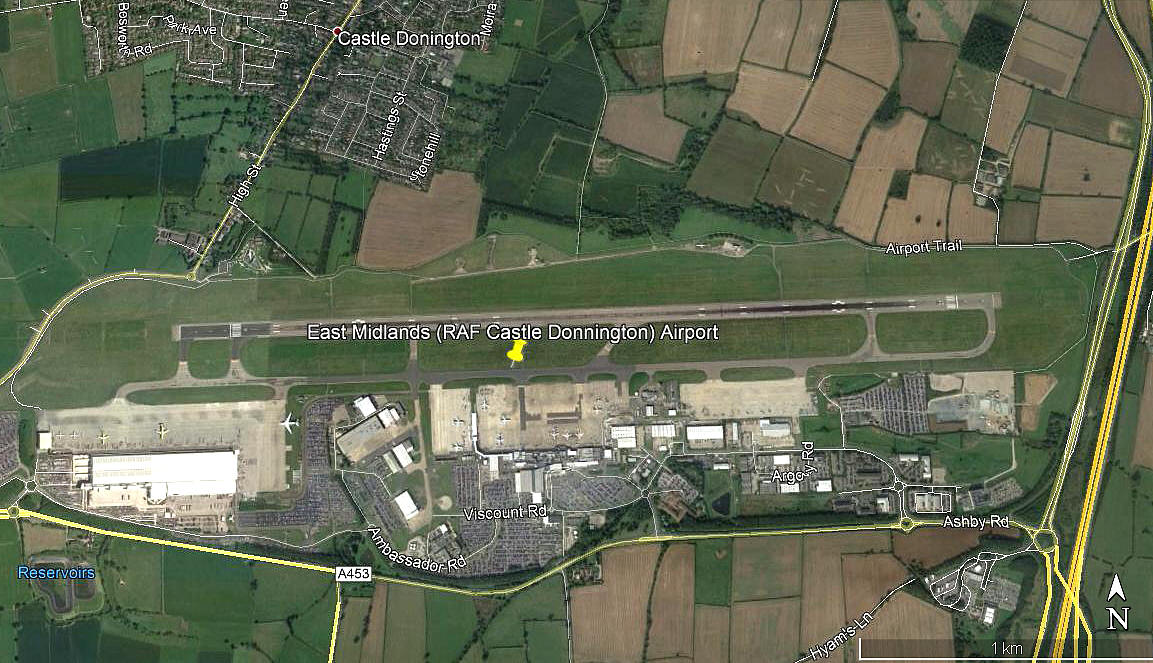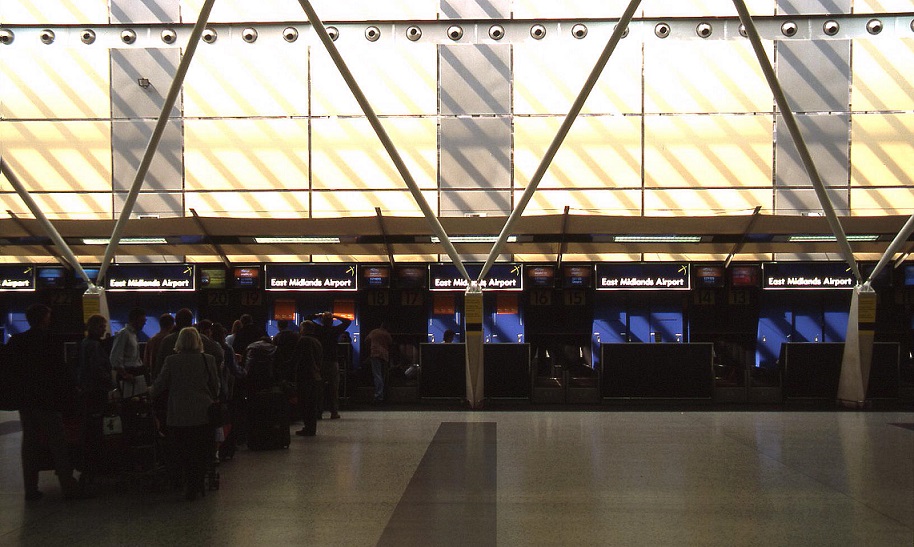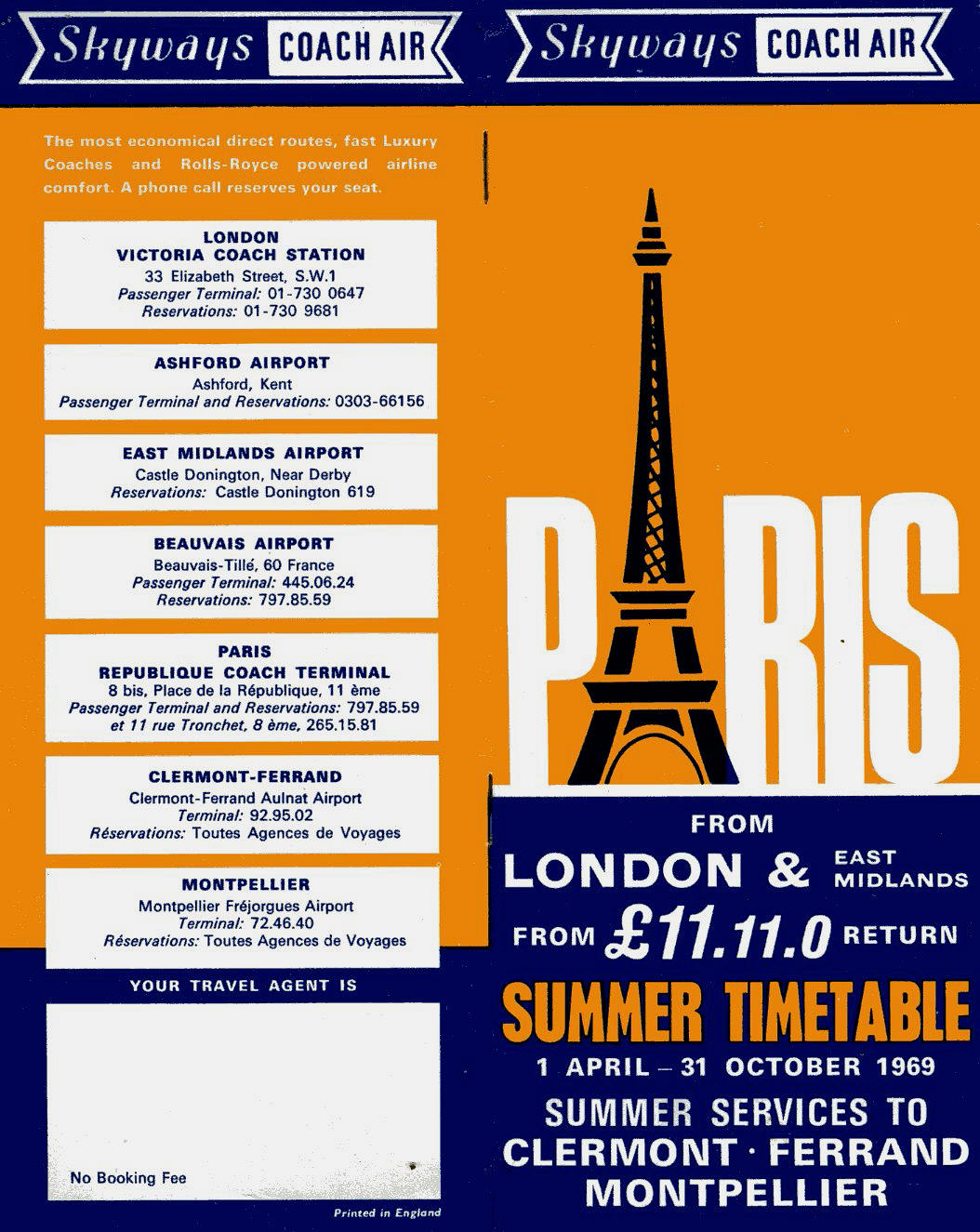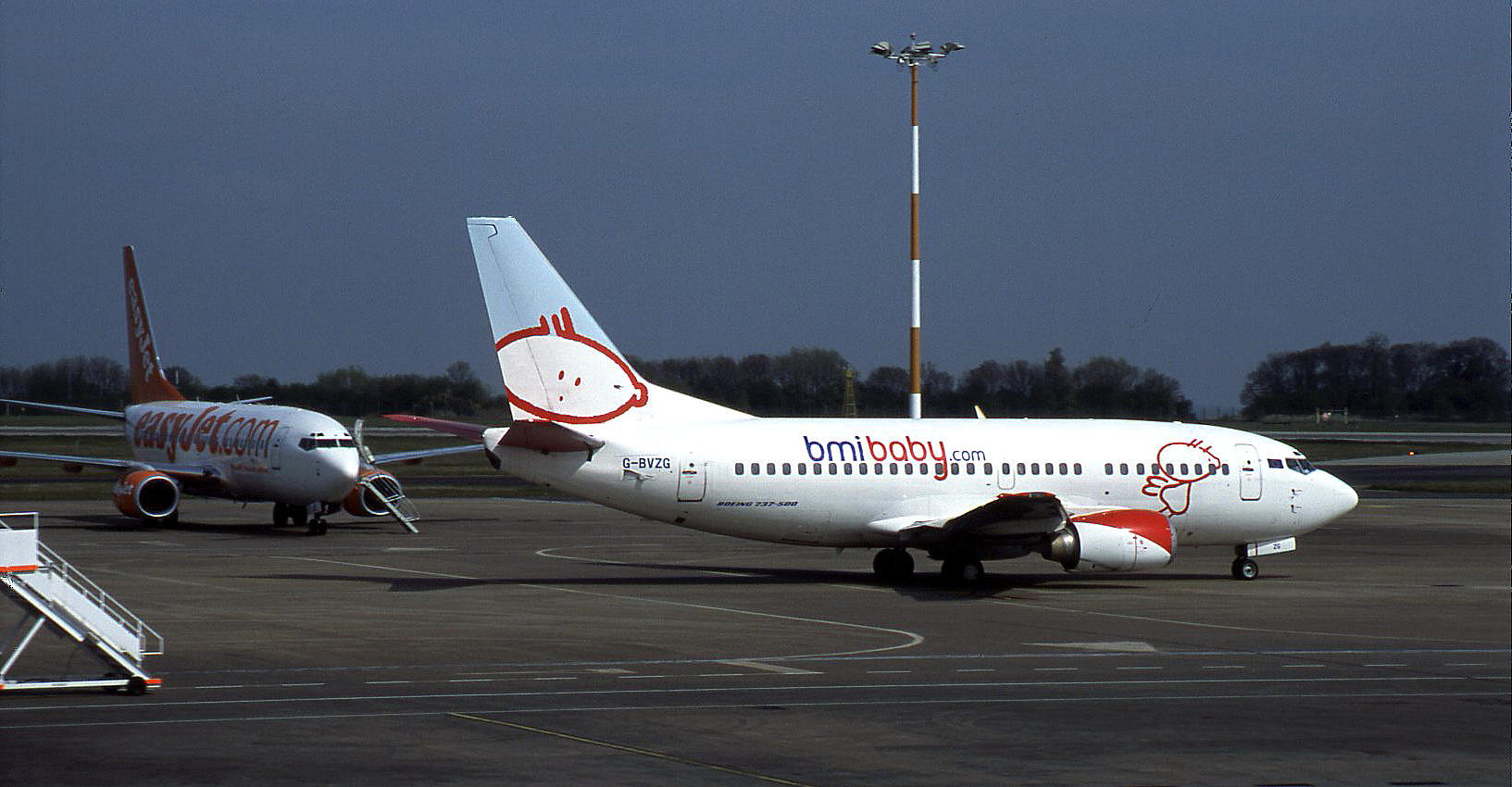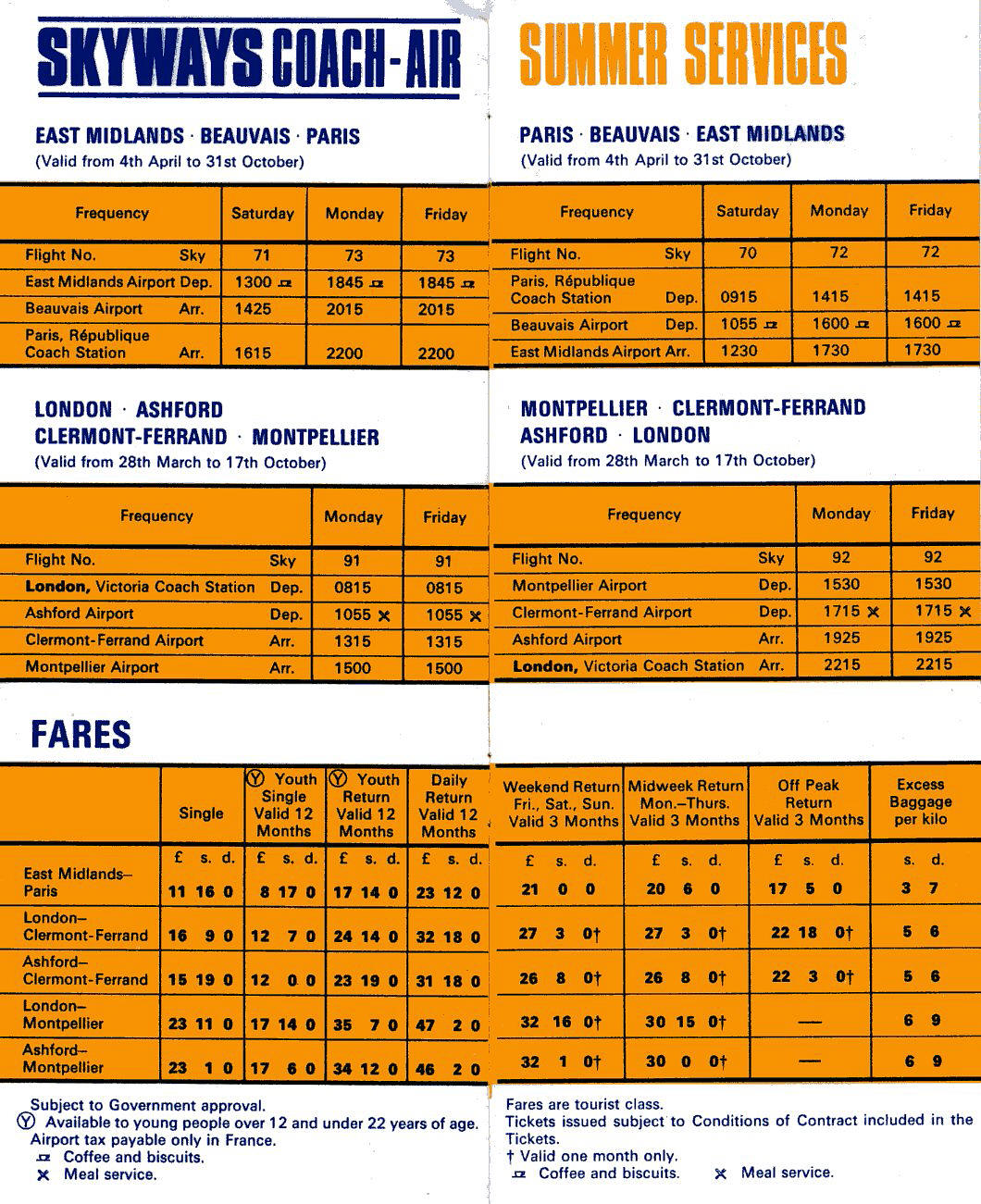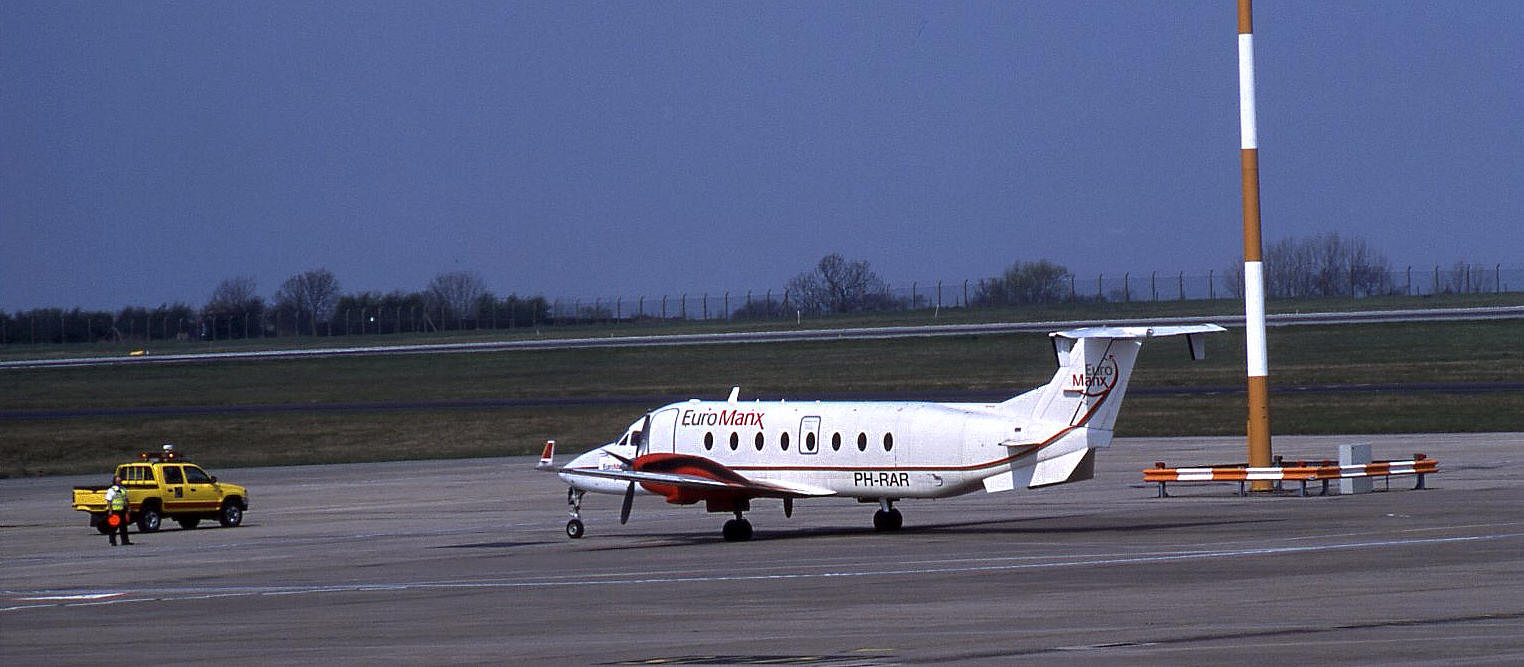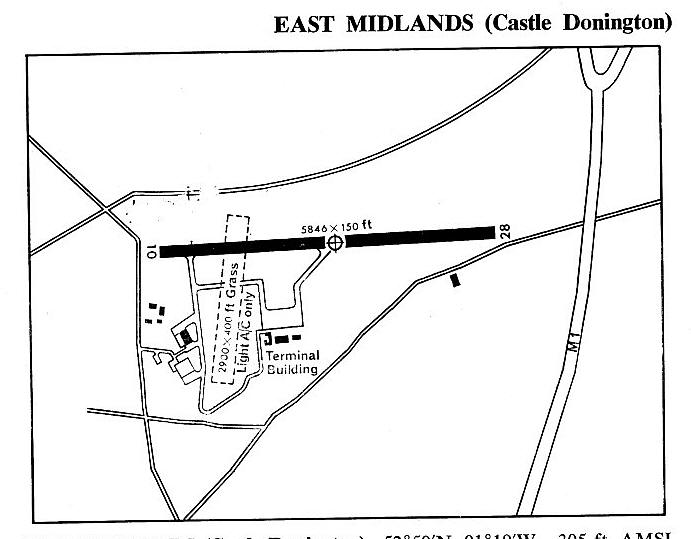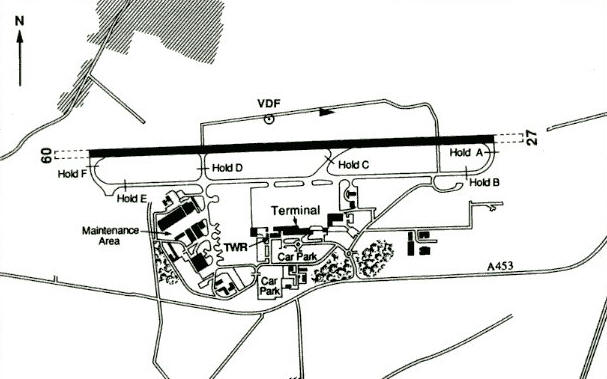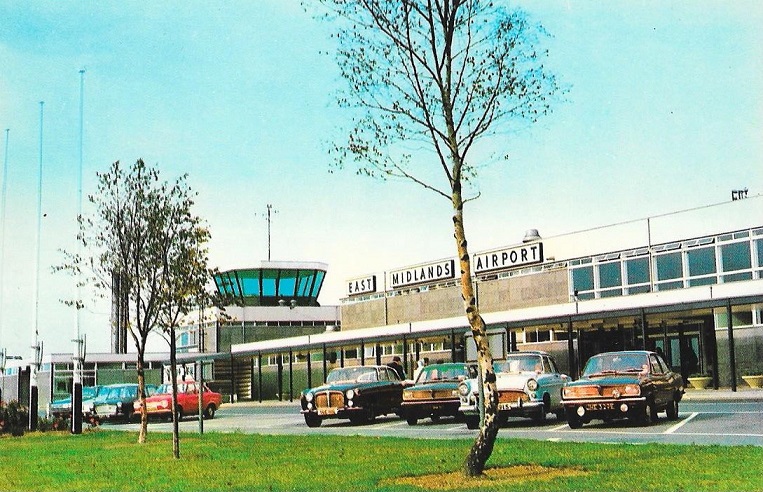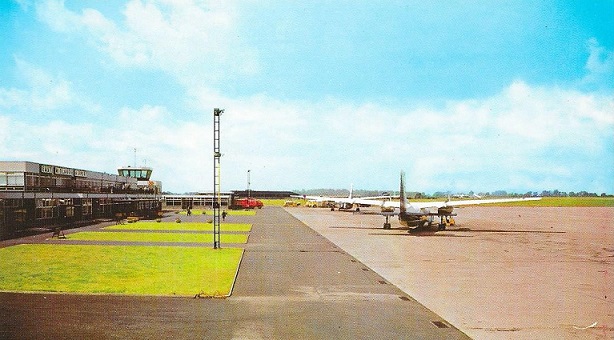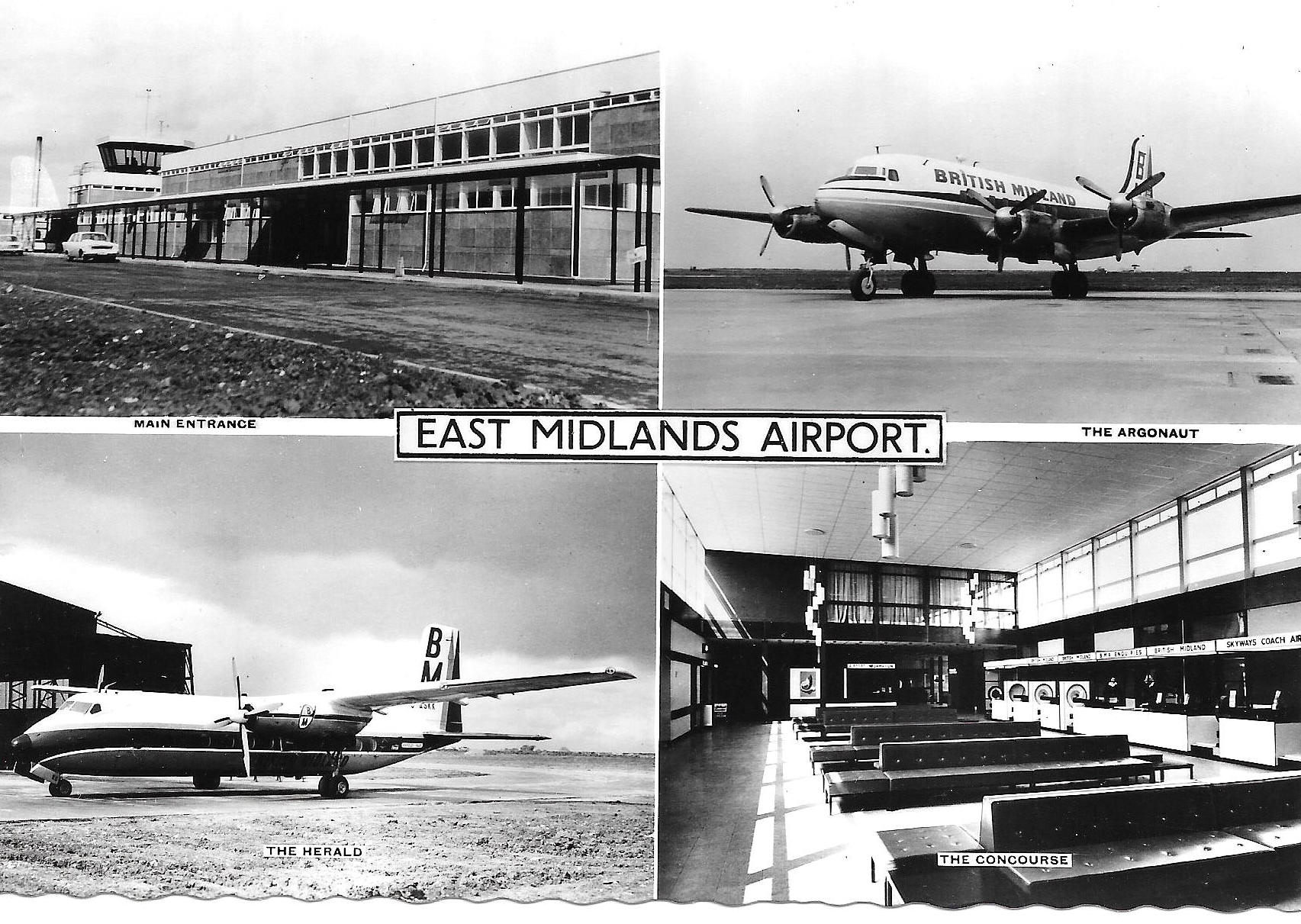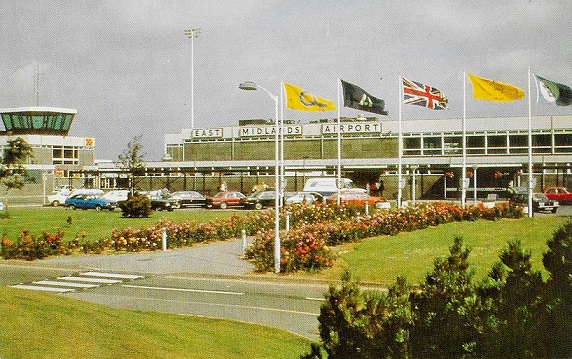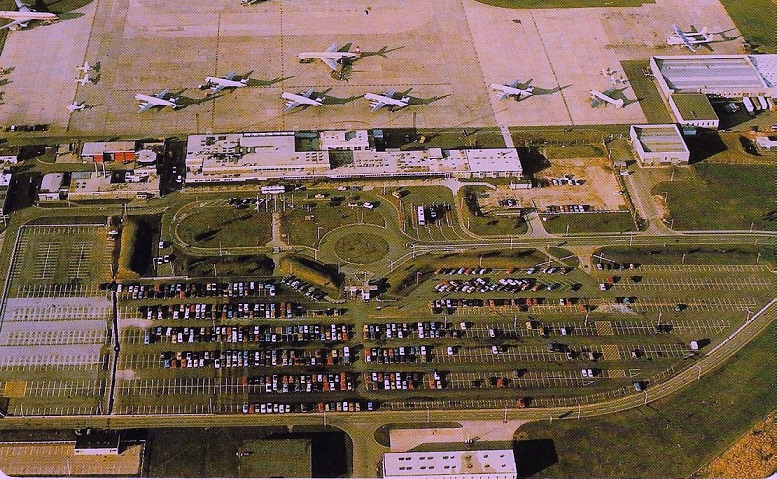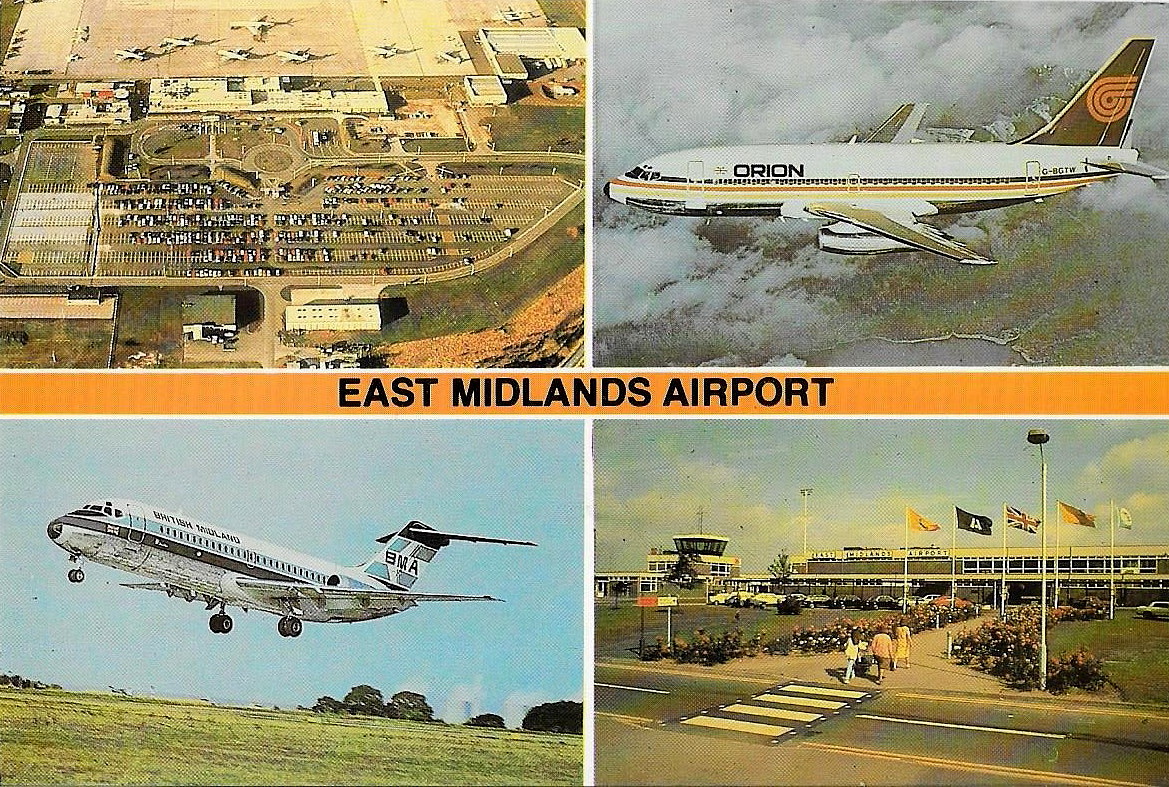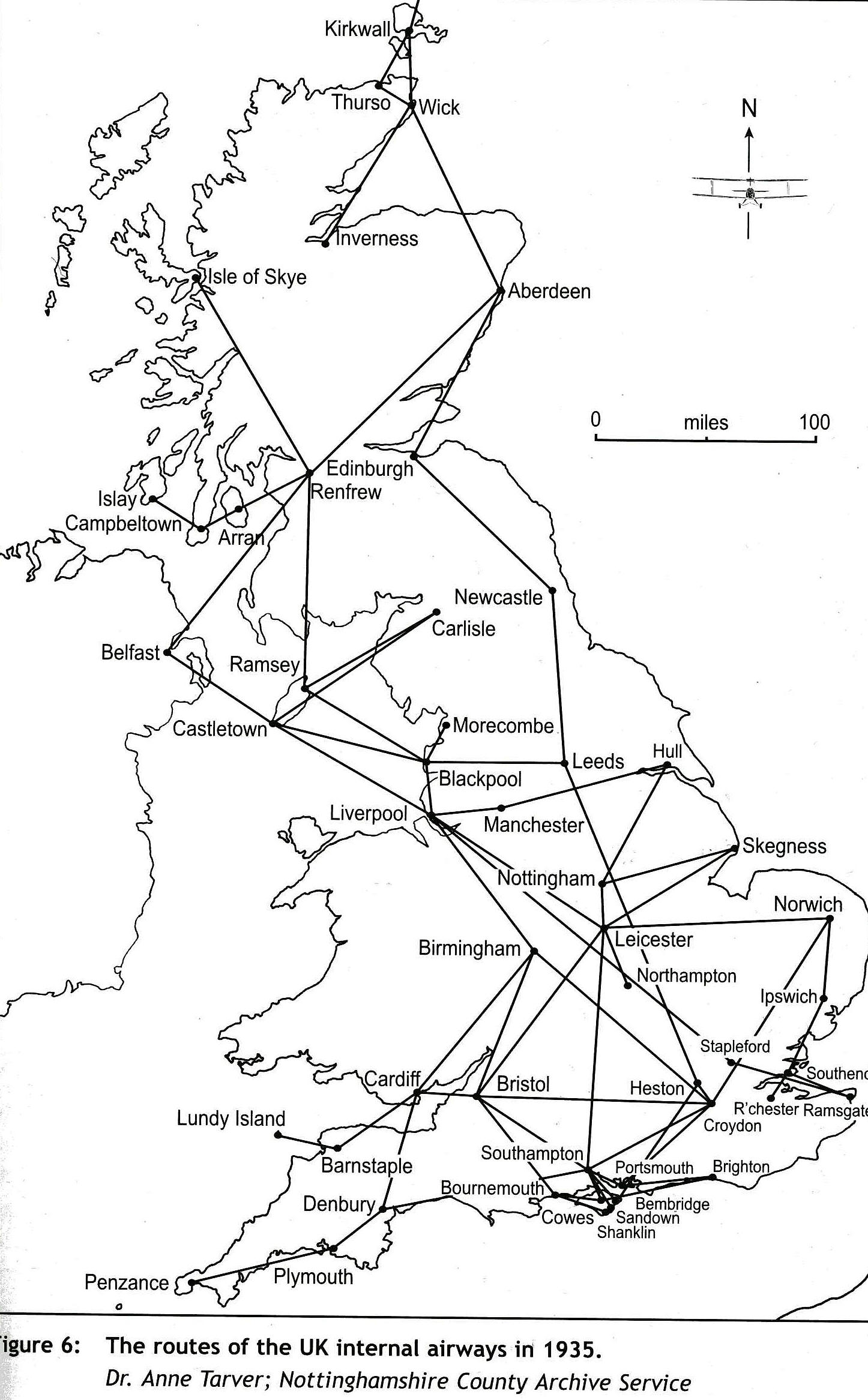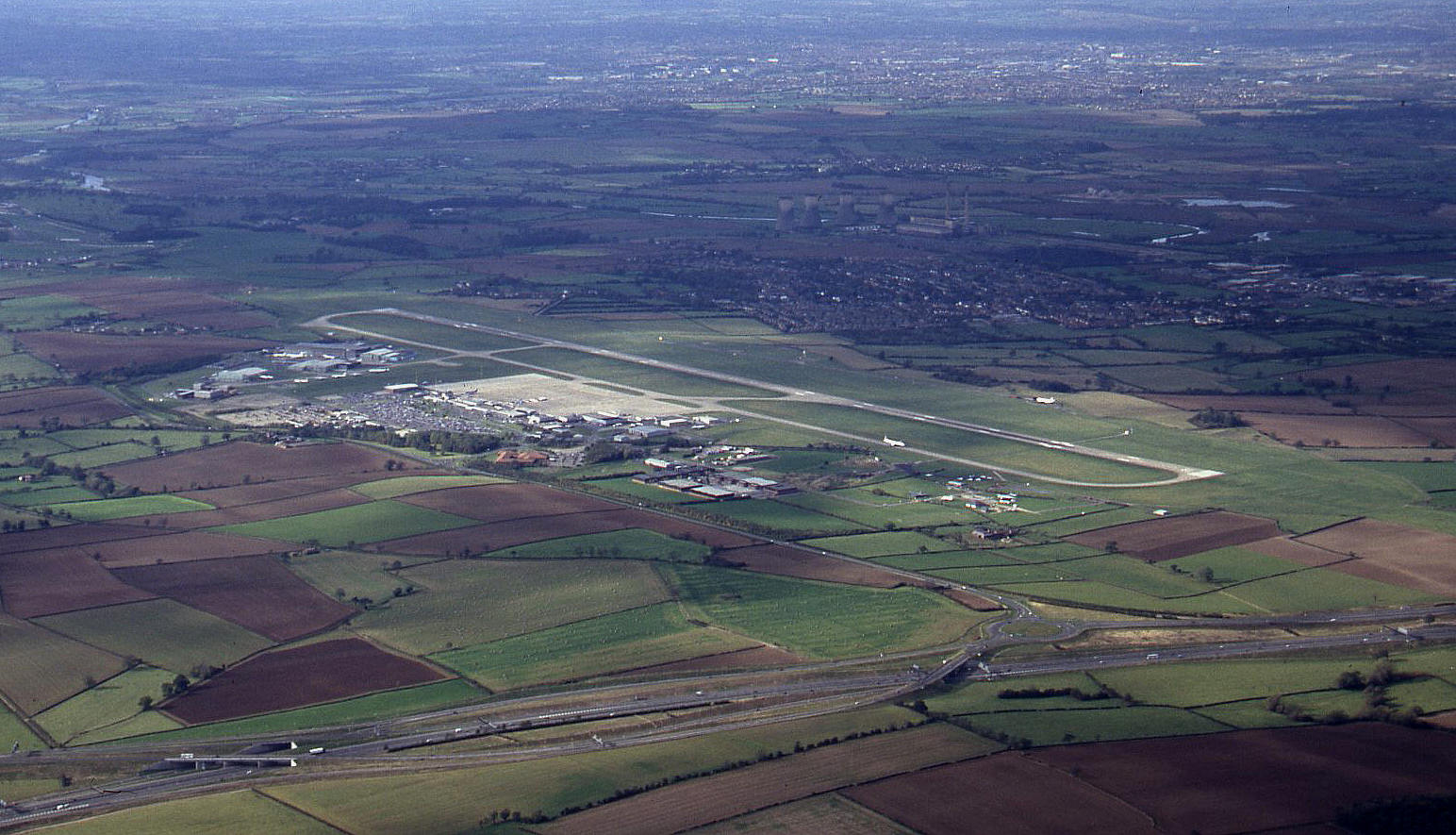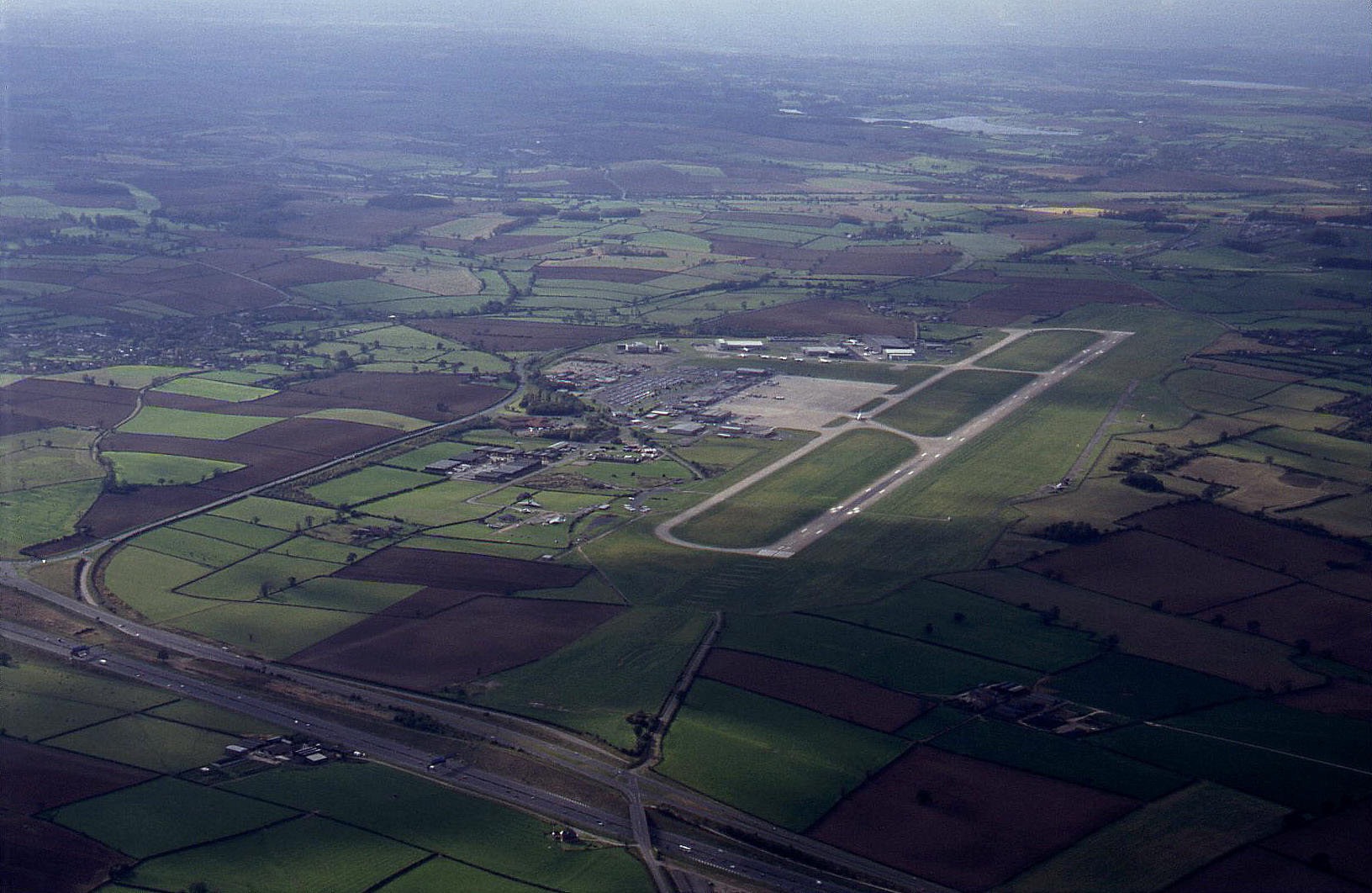East Midlands Airport
CASTLE DONNINGTON: Military Landing Ground, (in WW1), later military aerodrome, (in WW2)
Note: This picture (2016) was obtained from Google Earth ©
Later regional airport, known as CASTLE DONNINGTON AIRPORT, NOTTINGHAM EAST MIDLANDS AIRPORT and EAST MIDLANDS INTERNATIONAL AIRPORT
Note: Pictures by the author unless specified.
Opened as EAST MIDLANDS AIRPORT in 1965.
Apparently bizarrely renamed as NOTTINGHAM ROBIN HOOD AIRPORT in 2004.
In 2005 the ex RAF air base FINNINGLEY also adopted the “Robin Hood” name, reopening as a civil airport called ROBIN HOOD DONCASTER/SHEFFIELD AIRPORT. Which idiots were responsible for such utter confusing nonsense? What’s so wrong with calling it CASTLE DONNINGTON anyway? At least we’d all know where this airport is!
(Often listed as being in DERBYSHIRE in recent years)
ICAO code: EGNX IATA code: EMA
Military users: WW1: RFC 38 (Home Defence) Sqdn
WW2: RAF Bomber Command 28 OTU and Transport Command 44 Group OTU, later 4 Group Transport Command
Civil operator:
1965: East Midlands Airport Joint Committee
1990/2004: East Midlands International Airport Ltd (later plc)
Civil activities: Airline, air freight, charter, maintenance, GA business and private
British airline users: Air 2000, Air Anglia, Airtours International, Air World (Envoy), Alidair, Aurigny Air Services, Britannia Airways, British Midland Airways, Business Air, EuroManx, Flybe, Gill Aviation, Loganair, Monarch Airlines, Skyways Coach-Air, Thomson-fly
Foreign airline users: Air 2000 Airlines (Elite), Air Malta, European Air Transport (Eurotrans), Icebird Airline, Intersun, Lineas Aereas Canarias, Lufthansa, Onur Air, Nora Air Services, Quick Air Jet, Ryanair
Cargo and postal: ABC-Hunting, Air Bridge Carriers, Aurigny Air Services, Business Air, Hunting Cargo Airlines, Sagittair, West Atlantic
Charter & air taxi: Alidair, Britannia Airways, Channel Airways, Excalibur Airways, Genesis Airways, Hot Air, Inter City Airlines, Kestral International, Laker Skytrain, Orion Airways, Trent Valley Aviation**
Flying club/schools: Donair Flying Club, East Midlands Flight Instructor School, East Midlands Flying Club, East Midlands Flying School, NDS Flight Instructor School, Nipper Flying School
Helicopter ops: East Midlands Helicopters
Maintenance: British Midland Airways, Field Aircraft Services
Manufacturing: Nipper Aircraft
Museum: Aeropark Museum
Restoration: Trent Aero (Warbirds)
Location: 8nm SE of Derby
Period of operation: 1916 to 1918 then 1943 to 1946. Became a civil airport in 1965 operational to today
Landing area: WW1: 20 acres grass (roughly SE corner of present airport)
Note: These maps are reproduced with the kind permission of Pooleys Flight Equipment Ltd. Copright Robert Pooley 2014.
Runways: WW2: 10/28 1828x46 hard 05/23 1280x46 hard
15/33 1005x46 hard
1965: 10/28 1783x46 hard 02/20 884x122 grass
1970: 09/27 2286x46 hard
1990: 09/27 2280x46 hard
2004: 09/27 2950x46 hard
NOTES:
It is very important to credit the majority of the information contained in the 'Notes' of this listing (certainly up to 1979) to Capt B G Cramps excellent book British Midland Airways. I don't think there can be any doubt that British Midland Airways were, and indeed still are, a major force at EAST MIDLANDS. Having been recommended to read his book, it seemed to me a great opportunity to add quite a bit of this detail into this listing as it illustrates so much about the background of an independant British airline in the 1960s and 70s.
As pointed out many times elsewhere, this is purely a GUIDE and most certainly does not attempt to provide a comprehensive history of any site listed - an impossible task of course. What I have tried to do, where possible and with information at hand, is to provide insights into aspects of the history which I trust should be of interest to some readers.
THE START OF EAST MIDLANDS AIRPORT (AS OPPOSED TO CASTLE DONINGTON HISTORY)
The British Midlands Airways, (evolved from Derby Aviation), Herald 203 G-ASKK made the inaugral flight landing on the 2nd April 1965; it should have been the 1st of April but a bulldozer cut through the cables leading to the approach lighting. Some really special April fool that bulldozer driver must have felt then! In fact the BMA Herald, with Captain Lines in command had taken off from BURNASTON earlier with the Mayor of Derby on board on the 1st April to Glasgow (RENFREW), returning via YEADON (LEEDS/BRADFORD), and fully expecting to be the first to land at EAST MIDLANDS on the return flight. Apparently the DH.104 Dove operated by the Civil Aviation Flying Unit was making its final run-in on the approach lighting check (so the airport could be certified for night operations) when the bulldozer chewed through the cables and blacked them out!
The original ‘new’ (and only) E/W runway length in 1963 was to have been 1828 metres, exactly the same as the WW2 dimensions, but budget restraints limited it to 1615 metres. Needless to say, pretty soon after having become operational, this runway was quickly extended
**It appears an operation called Trent Valley Aviation which provided pleasure flights in the Midlands during 1968 and 1969 was based here. However, it seems they had no connection with the slightly larger operation by the same name, (taken over by Eagle Aviation in 1950 which was based at nearby TOLLERTON (NOTTINGHAMSHIRE).
EARLY DESTINATIONS
The initial 1966 list of destinations to be served by British Midland Airways from EAST MIDLANDS AIRPORT with scheduled services are as follows:
Barcelona (Spain), Basle (France/Switzerland via Mulhouse airport in France), Belfast (ALDERGROVE?), Bergen (Norway), Birmingham (ELMDON), Bristol (LULSGATE), Cambridge (TEVERTON), Cardiff (RHOOSE), Dublin (Ireland), Glasgow (RENFREW), Gloucester/Cheltenham (STAVERTON), Guernsey (Channel Islands), Isle-of-Wight (SANDOWN or BEMBRIDGE?), Isle-of-Man (RONALDSWAY), Jersey (Channel Islands), Leeds-Bradford (YEADON), LUTON, Manchester (RINGWAY), Newquay (St MAWGAN), Ostend (Belgium) and Palma (Majorca/Spain).
It is a long story but in and around the mid-1960s BMA did consider operating the BAC-111, purchased new, but eventually opted for second-hand Viscounts instead. Once again, as with the nearly disasterous Argonaut debacle, the senior management – with unerring consistency, made the worst possible decisions available to them. They were mostly different variants, creating a major headache for the engineers servicing them.
1967
In 1967 the first Viscount 736 G-AODG, reputably purchase for £175,000, was handed over in January and the BMA management were talking about purchasing ex-BEA Vanguards with the BAC-111 500 Series being another option. In the meantime a second Viscount 831 G-ASED was purchased. The Herald G-ASKK went in part exchange for the Viscounts. This year also saw the end of Dakotas in passenger service, so services to the Isle of Wight ceased.
On the 4th June BMA suffered its worst accident when their Argonaut G-ALHG crashed near Stockport having suffered two engine failures on the starboard wing. Sixty nine passengers and three crew perished although twelve people, including commander Captain Harry Marlow survived. No blame could be placed on either the company or crew but it resulted in the Argonauts being withdrawn from service. And probably about time too! This aircraft was a miserable failure and never ‘right’ from its inception. I wonder if, seen in todays terms, the senior management at BMA could (possibly?) face a ‘corporate manslaughter’ case charged with operating an obviously flawed aircraft type beyond a reasonable period in service, etc.
But things were different in those days.
1968
One thing did result very quickly indeed. In 1967 all BMA passenger flights were now turbo-prop types, albeit with five second-hand Viscounts. In April 1968 another Viscount (ex VR-AAN), was purchased from BOAC Associated Companies. This was a 760 Series and registered G-AWCV. The DC-3 G-APBC was then sold to Southwest Aviation of SHOREHAM (SUSSEX). In May 1968 yet another Viscount was acquired, this time from Alitalia (ex I-LIRE), a Series 785 and registered G-AWGV. I may well have my knickers in a twist here (by no means unknown) but I seem to recall that one of the many reasons for the phenomenal success of the Viscount was that Vickers would bend over backwards to adapt the type to customers specific requirements. Great for the first time buyer ordering a fleet, but for BMA picking one-off examples from various fleets – surely an unwise move? As I understand it, standardisation is the name of the game in airline operations, commonality of parts etc.
If forced (and I hope I won’t be) to name my all time favourite airliner, the Douglas DC-3 will probably be the choice. In October 1968 BMA sold G-ANTD “Tear Drop”, the companies first ‘Dakota’. To quote Capt Cramp once again, “”TD” had served continuously with the Company for thirteen years and had logged 13,600 hours with BMA alone, carrying some 250,000 passengers, and recently notched up her two millioneth mile of passenger carrying.” Not bad at all for a 1930s design.
It was also in 1968 that BMA extended their wet-lease concept, (aircraft with crews) but also including engineers. One Viscount went to Ghana Airways and a second to Nigerian Airways. The path to leasing a ‘virtual airline’ to emerging countries was well under way. On the freight side, just before Xmas, it was announced that 2,000,000 kilos of freight had been carried in 1968 on the Belfast service alone. I might not be readily appreciated today that freight operations had made a significant input into the success of the airline in those days.
A MIKE CHARLTON GALLERY
Notes: This gallery of pictures from postcards were kindly sent by Mike Charlton who has an amazing collection; See, www.aviationpostcard.co.uk
By all accounts Derby Airways, which became British Midland, survived despite its Managing Director who was, to all intents and purposes an utter fool. Totally incompetent commercially at least, (perhaps being ex-RAF had a major influence?), he was quite unable to understand the concept of cost benefit. The airline was on the verge of buying Douglas DC-6s when he found some Argonauts going for a knock-down price, so these were purchased instead. He had no idea that the Argonaut was far more expensive to operate, and hadn't the range and carrying capacity. Plus the very inferior Rolls-Royce Merlin engines had only half the TBO (Time Before Overhaul), of the Pratt & Witney radials fitted to the DC-6. And yet, the airline managed to survive! It wouldn't have in todays highly competitive climate, needless to say.
Note: The sixth picture, an aerial view, is I think especially interesting. It appears to show, apart from five British Midland Vickers Viscounts, a Boeing 707 in the top left hand corner; then left to right a DH106 Comet 4B, (probably operated by Dan Air?), a Douglas DC-3, an Armstrong-Whitworth Argosy freighter and five GA types. Can anybody kindly put a date to when this picture was taken?
The seventh picture shows an air-to-air picture of the Boeing 737-2TS G-BGTW, which operated charters for Orion whilst based at EAST MIDLANDS from November 1979 to March 1986. Also pictured is a British Midland Douglas DC-9, the first example arrived in 1976.
1969
In 1969 BMA announced a merger with Invicta Airways based at MANSTON (KENT), see MANSTON for fleet details. In January 1969 another Viscount joined the fleet, this time a Series 831 from British United Airways G-APND. The two Invicta Viscounts (G-AOCB & G-AOCC) were operated as British Midland but the Invicta C-54A Skymasters (G-ASEN, G-ASPM & G-ASPN) were operated as British Midland – Invicta Cargo.
Although the decision to operate the Viscount was unquestionably the right thing to do, the type did soon have two major crashes with BMA. To quote Capt B G Cramp again, “During a snow-storm at East Midlands Airport on 20th February Viscount G-AODG, the first Viscount to be delivered to the airline, was written off in a landing accident. As if this accident were not bad enough, at 15.58 on Thursday, 20th March, Viscount G-AVJA, with Captain I. Wallace in command, First Officer R. A. Weeks as his co-pilot, and Stewardess S. Wallis and Stewardess J. Timson on board crashed whilst taking off from Manchester on a training flight to Edinburgh, the only survivor being Stewardess Jane Timson.”
The Vickers Viscount was of course a huge commercial success and much appreciated by passengers – but - it had a dark side. It was far from being an easy aircraft for crews to fly, both in having little prop clearance for banking into crosswind landings and an over-complicated series of systems installed, be it hydraulic, fuel management etc, etc. It was I think the first commercial jet-prop airliner designed for operation by just two pilots, very appealing to the airlines of course, but the flight crew had to remain very sharp indeed throughout. It could bite the tired or unwary very quickly and sometimes did.
TRAINING AND DESIGN
Against this regular simulator training, especially for emergency situations, was still in its infancy. It is ironic, to some extent, that as the reliability of airliners has increased beyond measure to forty years ago, the frequency for very thorough simulator training to deal with emergencies has increased. This said standards still vary considerably throughout the world. For example, the top European airlines demand a degree of profiency which far exceeds those generally required in the USA. Australian pilots are regarded as top notch, which is why rich Arab nations employ so many, but elsewhere the picture is distinctly patchy. Without much doubt nearly all airlines throughout the world now employ competent aircrew, but – the degree of competence still has wide variations.
And of course the designers of aircraft still seem quite determined to make doubly certain that the subtle differences between similar types of aircraft can easily catch pilots out. Quite why they have this desire has never been fully explained. And indeed, it was just outside this airport, in the infamous 'Kegworth crash on the M.1' of the British Midland 737-400 on the 8th January 1989, that Air Accident investigators came to the conclusion that the layout of the engine instruments, especially in a high stress environment, could make it very easy to shut down the 'wrong' engine.
It seems to me very important to emphasise that in those days, (some will insist not much has changed), that the senior management in most airlines had little if no idea of the practicalities involved in operating aircraft. I think this quote from British Midland Airways by Capt. B G Cramp is well worth including in this ‘Guide’. “To make up for the loss of capacity due to the loss of the two Viscounts written-off in February and March (My note: 1969), the Company leased a British United Viscount G-APTD on the 20th April, augmenting a further Viscount, type 702, G-APPX, acquired from BOAC Associated Companies (ex VP-BBV) on 4th April.”
The BMA Viscount fleet now consisted of:
700 Series fleet: One Series 702, two Series 755, one Series 760 and one Series 785
800 Series fleet: One Series 814, one Series 815, three Series 833 and one Series 833
But, it wasn’t as simple as that.
“All of the above variants were different one from the other, although the 833 and 831 could be considered as the one basic type, the main differences between them being the radio installation. However, there was a major difference between these two and the 815/814 which again could be considered as virtually compatible with each other. The 810 series again were completely different from the 700 series which again within themselves differed immensely. As a result of all the above it was decided to “Fleet” the crews. Some of these flew all of the 833/831 and the 760 Series (known as Fleet I) and the rest flew the 815/814 and 785/755/702 Series (known as Fleet 2).”
MY NOTE: The designers at Vickers had, (and many in the industry at that time thought this), due to their arrogance and complete ignorance of actually flying, come up with a very dangerous combination of circumstances – very typical of the British aviation industry and perhaps most other countries at that time? I have the impression that US manufacturers were, at that time, trying to address the issue of standardisation?
Returning to B G Cramp: “All of this was necessary because of the complexity of flight deck layouts, Operation Manuals, check lists etc, and it imposed a tremendous strain on crewing, Engineering (and in particular the Stores because of spare parts holding) and catering due to the variations in catering equipment stowages, not to mention Reservations and Operations because of the varying capacities of the different Series.”
IS THERE A REASON?
It is now pretty easy to reach the conclusion that the senior management of BMA didn’t really have much of a clue as to what they were actually doing. Is it possible, or even probable, that this stems from them having a background in military flying, the demands of which are totally different from line-haul operations? For example, when evaluating turbo-props, far superior people in the lower management echelons had thoroughly researched the subject and recommended the purchase of Viscounts – resulting in a Herald being bought by the head honcho. Having eventually realised that was a mistake, and agreeing that Viscounts were the answer they then set about a programme of procurement which might well be seen as being the most harmful to the airlines future.
I suspect it might well have been that none of them had retained 'hands on' proficiency and might well of been thinking along the lines of; "They are all Viscounts for heavens sake, all pretty much the same." In his book, quite understandably being a very loyal company man, Capt Cramp makes no overt criticsm of the senior management of BMA in those years – but surely the record speaks for itself. By todays reckoning it seems very hard not to conclude They were nearly all verging on being utterly incompetent fools, having no idea whatsoever. Having said this, I found it very interesting that in 1969 five directors of BMA resigned “for personal reasons”. I wonder why? Very oddly, on that same day, as the resignations were announced, came the announcement that two BAC 1-11 jet airliners, Series 523, had been ordered for delivery in 1970, with an option for a third.
Without too much doubt the senior management arrangements of BMA were in turmoil and barely under control. Yet despite this the airline continued to prosper. Reading 'between the lines' this appears to have been mostly due to an intense sense of pride in the airline which had been formed over many years. This has often happened in all sorts of companies over the years. Given the happenstance (?) of highly capable and personable individuals being involved at all levels below the 'top rungs', the workforce have managed to create a tremendous sense of loyalty and purpose.
In 1969 Autair International decided their TEESIDE to HEATHROW service, using the Bristol Britannia 100 Series (operated by BKS) was non viable. So, no surprise there then. Autair succeeded for a short time to operate Avro 748s on the route. Capt Cramps book British Midland Airways can be recommended for several reasons, not least the politics involved and complex arrangements required by airlines to operate various routes. With Autair giving up on the TEESIDE to HEATHROW service, British Midland saw another opportunity.
A NEW DECADE ARRIVES
1970 was a big year for BMA as in early January their first pure jet arrived, the BAC 1-11 Series 523 G-AXLL. This was, I believe the first brand new aircraft ever operated since the days of Derby Aviation. What’s more the MD hinted of the possibility that Boeing 707s were in the pipeline – only they would be secondhand. On January the 22nd the BMA Viscount 814 G-AWXI had a serious engine fire shortly after taking off but managed to land back at LAP (HEATHROW) in minimal weather conditions. Everybody was evacuated with only three having minor injuries. The British Aircraft Coporation calculated that the starboard wing had only about twenty seconds of 'life' left when the aircraft came to a stop on the runway.
I think it is of interest to learn how long it could take to bring a new type of airliner into service in those days, or a BAC 1-11 at any rate. Delivered on the 5th January G-AXLL carried its first fare paying passengers on the EAST MIDLANDS to Belfast (ALDERGROVE) on the evening of the 24th of February. I suspect it usually takes much longer today? In mid-March 1970 the third and final BAC 1-11 arrived (G-AXLN) and the type was unusual in having an APU plus rear stairs, exiting beneath the tail, like the Sud-Aviation Caravelle and Boeing 727. This made it independent of ground handling equipment, especially when operating out of airports with few or no suitable facilities.
THE FIRST 707 FOR BRITISH MIDLANDS
Then came the first Boeing 707 – to quote Capt B G Cramp: “Speculation had been rife for some weeks about the purchase of long-haul 707 jets, after it was stated in the press that the Company were seeking U.S. Civil Aeronautics Board approval to operate trans-Atlantic charters, the flights being in six categories for group, single-entity, circle-tour and inclusive tour charters between points in the U.K. and points in the U.S. Permission was also sought for charter flights between 20 European countries and points in the U.S. Then, on the 26th March it was confirmed that the first 707, a Series 321, had been purchased from Pan American for a cash outlay of £1,600,000, and that an option had been taken on a second 707 for delivery in September. The first aircraft to be delivered, G-AYVE, was handed over to the Company on 1st April at Windsor Field, Nassau, in the Bahamas. The ceremony took place immediately after the aircraft arrived in Nassau, following a 4-hour delivery flight from the Boeing plant at Wichita, Kansas.”
“The 707 Fleet Captain, Captain “Billy" McCash, commanded the aircraft when it left…for Miami International Airport, Florida, where intensive crew training was carried out under the supervision of Pan American Airways training staff. After the training was completed, the Boeing, with 189 economy class seats, was ferried across the Atlantic on Sunday, 26th April via Gander and Keflavik, to become the first Boeing and the largest aircraft yet to have landed at the East Midlands Airport.” I would imagine that bringing two entirely new and different types of jet aircraft into operation during the same period must have been highly stressful for the operations and maintenance management staff especially, although maintenance of the 707 was sub-contracted to Aviation Traders at STANSTED where the 707 was based.
As recommended before, reading Capt. B G Cramps book British Midland Airways gives considerable insight into the ‘behind the scenes’ trials and tribulations of running an airline. It is beyond the remit of this GUIDE to go into detail but I do reckon the following should be included, not least because it illustrates just how paranoid the US administration was (and still is) regarding foreigners intruding: “No passenger-carrying U.S. airlines made any objections to the application being made, and a C.A.B examiner recommended that a “Foreign Carrier Permit” be granted.” (My note: Please remember that we Brits apparently still have a ‘Special Relationship’ with the Americans in the USA) “On the 28th May President Nixon approved the granting of the permit, which was issued on 2nd June. The speed with which the permit was obtained, altogether 12 weeks from start to finish, and the hearing only lasted one day, was at that time without precedent. Indeed, the speed with which the type endorsement on the Air Operator’s Certificate was achieved stands as something of a record in itself, it being barely five months from the time the decision was taken to enter the long-haul jet field to the A.O.C. endorsement being awarded in May.” (Please bear in mind that Capt Cramps book was published in 1979.)
It took me a couple of minutes to absorb this. What we are talking about is a fairly modest and privately owned British airline with one American airliner, purchased in the USA from an American airline which had been refurbished in America, had had crews trained in America and would require operational support from America. The operations planned posed no commercial threat to U.S. airlines – but, granting this still required the approval of the President!
MUCH ADMIRED
As you might well have realised by now, I have considerable admiration for Capt B G Cramp. Much increased when he mentions he left BMA in January 1966 to emigrate to Canada to fly float-planes, and that is real flying. Involving being a sailor as well as pilot. He returned to BMA in 1970 to become a Viscount Training Captain and Instrument Rating Examiner.
BACK TO 1970
To quote Capt B G Cramp yet again; “ At the end of 1970 it was decided that flying training no longer fitted into the Company’s requirements and so it was that the Midland School of Flying ceased to be operated by the Company, although the Chief Flying Instructor, Frank Spencer, bought the School himself and continued to operate it under the same name, thus in a sense continuing the long line. It was 32 years previously when Air Schools came into operation and there had been an unbroken continuation of flying training ever since.” The foundation of Air Schools led directly into Derby Aviation, Derby Airways and British Midland Airways. I would guess this decision was probably a mistake in the long run, given that having an ‘in-house’ flying school provides an airline the opportunity to nurture pilots in exactly the way they want them to conduct themselves upon becoming line pilots. Against this of course, are the benefits of having pilots with another, or ‘fresh’ attitude. I expect the argument can never be resolved?
HARD TO BELIEVE?
Another story, in many ways indicative of the times, is also told by Capt B G Cramp: “A first-class row blew up in May when a major U.S. tour operator, American Charter Company, reluctantly forced the Company to transfer its U.K. trans-Atlantic terminal from Castle Donington to Stansted, due to lack of immigration officials at the airport, and the lack of currency exchange facilities. In a statement to the press Mike Bishop (My note: MD of BMA) said that East Midlands Airport had thrown away its chance to become an important terminal for international air traffic. The Company was extremely disappointed and very concerned about events since the Boeing flights from Seattle to Castle Donnington had started two months previously. A strong commercial effort had been made to transfer the trans-Atlantic operations to the main base airport for obvious reasons, and there had been nothing but problems. A lot of foreign visitors had gone to the airport and received a distinctly bad impression. Both British Midland Airways and the Airport Authority had stood to profit if the service had remained at Castle Donington, both financially and in the long-term. The sums of money involved were not small, as the airport would have made a minimum of £50,000 in landing fees alone, apart from the prestige involved. The Company stated that there would not be any expansion of British Midland Airways operations at East Midlands until services improved.”
CUSTOMS & EXCISE
This might be as good a time as any to make a few remarks about British Customs & Excise. As an Authority they have far greater powers than any other, including the Government and Army, but this can hardly be an excuse for deliberately trashing the countries reputation in the eyes of foreign visitors in those days – and they are sometimes much better today of course. To continue the story from Capt Cramp; “ The main problem, not entirely the airport’s fault, was because one immigration officer, who had to travel all the way from Hull, was supposed to deal with 186 passengers of every nationality. In addition the airport bank opened only twice a week and, of course, this was completely inadequate.” You can’t of course blame the unfortunate Customs Officer or the part-time bank teller/manager – the problem of arrogance was at a much higher level and reflects, if nothing else, an appalling disregard, lack of manners and thoughtfulness for the basic human needs of weary travellers.
Without any doubt whatsoever, this reflects an abysmal lack of 'joined up thinking' at very senior management levels regarding pre-planning when launching such a major project.
SOMETHING HAPPIER IN 1971
Again from Capt Cramp, but this time on a happier note; “The biggest aircraft ever to have been handled by the Company to date arrived at East Midlands Airport on Saturday, 5th June, 1971. Registration number N301EA, the aircraft was the prototype, Lockheed 1011 Tri-star, returning to California after being present at the Paris Air Show. The stop-over at Castle Donington was to show the workers at the Rolls-Royce engine factories at Derby the aircraft into which their RB.211 engine had been installed. The aircraft did not present any handling problems directly, but indirectly caused some chaos as passengers travelling on the Company’s services (and for that matter aircrews operating these services) could not get to the airport on time due to the terrific queues of people and cars trying to get a glimpse of the new wonder.”
A MAJOR "CATASTROPHE" FOR EAST MIDLANDS AIRPORT
As an aside, the second day of the first ever British Truck Racing event at Donington Park in 1984 caused even greater chaos and I was there with my wife and children, already ensconced in a motor-caravan on site. The truck manufacturers and major potential sponsors such as oil companies etc had mostly regarded racing trucks as being akin to delinquency, which in many ways it was. For that first event it was simply truck drivers, some owner drivers, others owners of haulage firms etc, competing for the first time and racing unmodified regular road going trucks, just the tractor units of course – which weren’t fitted with speed limiters in those days. On the first day of racing I had never seen anything so absolutely thrilling and immensely funny – it was sensational and the bush telegraph went berserk. As we ventured out in the morning from the camp site that we reckoned we could see the sun glinting off stationary cars all the way back to Birmingham.
This wasn’t much of exaggeration as EAST MIDLANDS AIRPORT had to be closed, because it was impossible for the emergency services to reach the airport. Needless to say, after this all the manufacturers and sponsors queued up to get involved and very quickly the ‘sport’ became as boring as Formula One. At the risk of boring you the winner was an Italian (I believe an owner-driver) who drove very fast but very smoothly. It was said he’d swopped tyres from his trailer so it wouldn’t cost him too much it he blew one – or two. On the Monday morning I was heading north on the M.1 in my truck when I spotted him going home, heading south, now with his semi-trailer attached of course.
A RECORD?
Has there ever been any other sporting event, held anywhere, that has proved so sensationally popular, literally overnight, that a major airport had to be closed?
ANOTHER RECORD
Returning to aviation matters, and the British Midland Airways book, “Vancouver to East Midlands non-stop, that was the record set up on Sunday 5th September by one of the Company’s Boeing 707s. The 4,800 mile flight normally called in at Keflavik, Iceland, but favourable winds allowed the flight to carry on towards Stansted, its scheduled destination. However, there the weather was poor and so East Midlands was selected as the alternate. It was the first time the Company had made the flight non-stop, and it was the first flight into Castle Donington direct from Vancouver.”
Have you noticed how, in his accounts, sometimes in the same paragraph, Capt Cramp often alludes to this site as being either CASTLE DONINGTON or EAST MIDLANDS AIRPORT? I might be mistaken but in those days at least, and possibly for many years later, I reckon older pilots preferred to respect the site by its original name. I certainly still do but possibly more out of a sense of respecting the history than anything else. I thought it a major step in the right direction when LAP (London Airport) became HEATHROW. Or, as many passengers call it, ‘THIEFROW’. I strongly object to the tendency to rename airports after famous local people (some even mythical) and much prefer the original place names. I also reckon it gives visitors a much better feeling about arriving at an historical site.
A MAJOR DECISION
To return to Capt B G Cramps book British Midland Airways this seems another story well worth telling: “Having announced its intention of concentrating on scheduled services and running down the inclusive tour activities, the Company now had to find increased aircraft capacity to live up to its declared undertaking of entering the Continental scheduled services market early in 1972. With this in mind therefore, Board sanction was sought and obtained to finance the purchase of two more Viscount 810 Series aircraft, but at the beginning of the year there was no clear-cut idea of where the aircraft were to be obtained from.” This “beginning of the year” must have been in 1971 of course.
“In the latter part of November 1971, Mike Bishop had travelled to Tel Aviv on business and before leaving London Heathrow had purchased a copy of ‘Flight International’ purely with something to read en route in mind. In the “Aircraft for Sale” column was an advertisement that was to profoundly change the course of British Midland’s path, and which prompted one speculative remark in a newspaper column that the Company was to acquire South African Airways entire fleet of Viscounts at a price of £750,000. The true story is as follows:
The advertisement read by Mike Bishop did indeed refer to the sale of the entire S.A.A. Viscount 813 fleet, and, having concluded his business in Tel Aviv, Mike made his way South to Johannesburg. On arrival disappointment reigned supreme when S.A.A. state that, contrary to the content of the advertisement, the Viscounts were to be sold as a fleet complete with spares, and not separately. This presented quite a problem for cash was only available for the two already authorised aircraft. However, completely unabashed, this amount of money was offered for the entire fleet of 813s. Imagine the surprised look that surely must have appeared on MikeBishops face when the offer of £98,000 plus £37,000 for the entire Viscount spares holding was accepted. The latter figure was later raised to £42,000 but to now include the Viscount flight simulator.”
Without any doubt a most astonishing deal, certainly one of the best at first glance ever made in aviation history? But, there were a few problems as BMA now had seven extra Viscounts and none of them could be operated in the UK and Europe without serious modifications. I’ll bet the BMA maintenance blokes almost cried hearing what was in store, but perhaps later cried for joy, realising the overtime involved? I wonder, having read the account, if BMA actually made a significant profit from this deal? One thing is certain, all the seven ex-S.A.A. Viscounts were in service by June 1972.
The first procedure was to get shot of the existing Viscount fleet. G-AVJB went to Kestrel International also based at EAST MIDLANDS as were Alidair who took G-ASED. Arkia of Israel purchased G-APND and G-APNE. Now then, I might well be a cynical old sod, but exactly why did Mike Bishop fly to Tel Aviv “on business” prior to learning about the SAA Viscounts being for sale? I strongly suspect the Flight International story was a smoke-screen and he had a pretty shrewd idea how to handle the entire deal long before? Without too much doubt I’d reckon that the appointment of Mike Bishop as Managing Director of British Midland Airways was probably the saviour of the company. He was very outspoken and one of his favourite expressions to users of BMA services was, “Use it or lose it.”
CATCH 22?
In British Midland Airways Capt B G Cramp describes a most astonishing episode in 1972 which fully illustrates the regime in the USA which since WW2 at least seems quite determined to put anybody off visiting the country – unless it suits them of course. Mind you, the UK has similar regimes in place. Make no mistake about it, this US official regime is still in place although most visitors won’t be aware of it. For example, an airliner from a major national carrier from an EU State took off for New York knowing full well that the eastern seaboard of the US was mostly fogbound. Not a problem as the crew were fully trained (as most if not all EU airline crews are) to operate under CAT.3 conditions. On approach to the New York airport the crew requested the CAT.3 runway only to be told it wasn’t available, so they initiated a diversion only to discover, once close, that this airport’s CAT.3 runway wasn’t available either. So, a third diversion, by now to Philadelphia, was made – and – you’ve guessed it, the CAT 3 runway there wasn’t available.
By now the airliner was very short of fuel so the crew demanded the CAT.3 runway be made available, failing which they’d declare a May-Day which has serious ramifications of course. Heh presto, the CAT.3 runway was suddenly available and the airliner landed safely. The captain, by now very annoyed, stormed up to the FAA office at the airport and demanded an explanation. This they received in a remarkably frank manner; It appears it is official policy to deliberately hinder inbound flights from EU States (and others) in such and similar circumstances, who have crews this highly trained. Because - US crews are not normally so highly trained and therefore the foreign operators have a distinct commercial advantage! If only those passengers knew…..
You might well be wondering how I came to be privy to such information? Over the years I have heard many ‘privileged’ stories, simply because I am also a pilot, albeit only a lowly private pilot. But here is the fact of the matter, all pilots share a sense of responsibility to disseminate advice and information with other pilots (regardless of rank or status) which affects flight safety and most take this very seriously – including military pilots. It might also be just possible that having been a correspondent in aviation matters it was thought there was a very small chance I might find a way to ‘leak’ these stories. I should also make another important point and this is that over many years I have never found such accounts to be even slightly false or in any way exaggerated – and indeed, if anything quite the opposite and underplayed.
Most airline pilots are certainly guilty, when dealing with the public at least, of being far too modest. I have had the distinct privilege (no longer available) to have sat on the flight deck of many airliners, including during the approach and landing phases. Plus, I have twice had the opportunity to experience ‘flying’ an airliner in a simulator (remarkably real) and attempted approaches and landings many times. I would emphasise ‘flying’ as I took no part in configuring the airliner, making all the necessary pre-landing checks, ATC calls etc, etc. Let alone having any situational awareness.
And yes, I did manage every landing more or less safely – a couple were ‘greasers’ too. Between you and me please don’t mention that this was always in calm conditions with excellent visibility. I think that I should mention that after both sessions I had to take great care driving home as I was utterly exhausted. In fact, when sitting in the jump seat on approach, I cannot think of any other 'work' environment which gets so very busy so quickly, and, needless to say, it has to be got right every time!
HOW ABOUT THIS
Back to a story in 1972 from Capt Cramp: “In early February, the U.S. Civil Aeronautics Board named B.O.A.C., Air India and B.M.A. in a suit filed in Brooklyn alleging illegal charter operations. The facts behind this rather alarming situation arose out of the almost impossible task of trying to enforce the rules on trans-Atlantic charter flights, in which passengers who travelled on so-called affinity group charters were required to have been fully paid-up members of the club or association with whom they were travelling for at least six months. The onus for checking the bona fides of passengers travelling on any particular flight fell on the carrier, and not on the person or company who was in fact organising the charter flight. The requirement was almost impossible to impose, for how could any carrier check out the credentials properly? However, both the C.A.B. in the U.S. and the C.A.A. in the U.K. carried out snap checks on passenger lists of aircraft about to depart east or west from the U.S. or U.K. with the result that many flights were cancelled leaving passengers stranded both sides of the Atlantic and often with the hapless airline having to operate across the Atlantic empty.
Small wonder then that B.M.A. made a loss. In addition, because flights were discovered to be “illegal”, Government, mainly the U.S., filed suits and imposed fines. The passengers, in the meantime, invariably walked round the corner and travelled quite often on a scheduled carrier.” The American C.A.B. made no bones about it stating, even at the appeal court; “…that in 1972 it was going to have a purge on British carriers and their commercial profit in the U.S.” Mike Bishop, the BMA M.D. said, “This is discriminating and has been one of our main causes for concern. In fact Mike Bishop alleged that BMA had discovered that the C.A.B. had itself been booking “illegal” passengers onto their flights. This practise is I believe, technically called ‘entrapment’ and in most western countries would, even back in 1972, been considered illegal. Mike Bishop didn’t go that far though, simply stating, “We believe this was unfair and unjust.” Damned right it was.
To quote Capt B G Cramp again; “After the preliminary hearing, judgement was deferred until the main hearing which took place in Spring 1973, when the Company were judged guilty of carrying illegal passengers and a “fine” of U.S. $50,000 imposed which was paid, following which B.M.A. were absolved from any further liability. As pointed out elsewhere in this GUIDE I have never had any problems with the American people and in fact, from personal experience have found them mostly very friendly and generous. My problem has always been with the succession of U.S. Governments and their administrations, plus the attitudes of the U.S. Military establishments.
BACK TO THE SUBJECT IN HAND
By some luck perhaps (and certainly by having a previous first class reputation through another contract elsewhere in Africa) in late 1972 BMA secured a short term contract to operate a pretty much fully fledged airline operation for Sudan Airways which involved providing aircraft, crews, technical and management assistance, and a training programme for flight deck and cabin staff . What a contrast to dealing with U.S. authorities.
In February 1972 Channel Airways went bust and BMA brought the airline. The Channel Airways network was, when it closed: SOUTHEND to JERSEY & GUERNSEY, BOURNEMOUTH (HURN) to JERSEY & GUERNSEY and STANSTED to JERSEY & GUERNSEY. Once again the risks in operating an airline were highlighted in this takeover. After A.T.L.B license hearings, BMA were given the STANSTED and SOUTHEND licenses but Dan Air were given the BOURNEMOUTH route. That must have been a very bitter pill to swallow?
Except that things weren’t so simple. As it happens BMA could still operate some services from JERSEY to HURN. But was small beer compared to what was about to happen on the 10th April 1972. It is probably rather difficult to explain to younger people today just how hide-bound and entrenched in virtually paranoid protectionism for national interests all countries were, even up to thirty years ago. Despite the fact that the major international "criminal elements" (chief bankers etc) would predictably invade governments within the EU, the concept of free borders has been a major achievement for the general populations.
To illustrate this I will quote Capt B G Cramp once again, from his book British Midland Airways regarding 1972: “On 15th March, it was announced that the Belgian and West German authorities had granted traffic rights between Brussels and Frankfurt for the service that was to begin on 10th April. This was the first instance of a British Independent carrier being given fifth freedom rights i.e. allowed to pick up traffic in a foreign country destined for another foreign country, between these two countries for a scheduled service.” The fact is this was a hugely significant achievement. I will make no bones about it, I am very proud to consider myself a ‘European’, the fact that I was born in the UK being entirely incidental. For me the EU has been my workplace, and has been for over forty years and my love for Europe has never diminished – indeed it has grown stronger with every year.
So, as this is my 'Guide' may I have a small rant please?
Note: This 'rant' was written well before the bombshell 'Brexit' vote.
REGIONAL IDENTITY
Far from the often heard mantra that the EU is all about subsuming regional identities, the plain fact is that exact opposite is the case. On a holiday in 2014, whilst in a hotel in Sofia, Bulgaria, I fell into conversation with a professor of politics and economics; an Englishman who had recently taken up a post at the main university there. I was very pleased to hear that he entirely agreed that this was the case. Incidentally, and I trust you will find this noteworthy, he had found it almost impossible to gain a post an a British university because, with three Masters Degrees, they complained that he was too highly qualified! Now then, can anybody please explain to me just how the hell can any professor be; "too highly qualified"?
Having driven a truck across most of Europe for some forty years, I have always maintained that as the EU expands the sense of regional identity will increase. And this is exactly what has happened. The urge from regional populations to claim an independent identity has never been stronger, and quite rightly so considering that most nations within the EU were cobbled together by ruling factions obsessed with outmoded concepts of mostly domination won by political entities relying on military and/or religious connivance. With no respect for the populations being subjugated.
You have only to travel throughout most countries in the EU to quickly realise that it is the regions that really matter to the people living there. And, that the regions are so diverse that being incorporated within a ‘country’ almost makes no sense at all. I doubt it will happen in my lifetime but, I would dearly love to see all of Europe become a single entity comprised of dozens and dozens of self administering regional entities, all playing a part to support the whole.
In the meantime the news that major global enterprises and many governments in EU States have been, quite predictably, pretty much "hi-jacked" by the "master criminals" (as in bankers and lawyers etc) comes as no surprise. What I look at is how the life-style and quality of life of so many of the people of mainland Europe is leaving a large proportion of us Brits way behind. Yes they have problems, often very severe problems, but few regions exhibit the degree of delinquency, crime and general social disfunction the U.K. has, especially in England.
Just one more point if I may. Whilst in southern Bulgaria I had the bright idea of making a short diversion into Turkey for a few hours. It turned out to be a grim reminder of how much of western Europe once was about forty years ago. About an hour and a half of queuing at several windows, (despite there being very little traffic), and entering Turkey for this brief period had cost us roughly £150 for visas and insurance.
It has long been my belief that in the UK we should be doing much, much more to promote regional identities, and regional air travel. Just have a look at the map of regional air services in 1935. Obviously with our modern motorway and rail network, many of these routes would not be viable, but, I still maintain that with a flexible 'common server' internet based booking structure, and given a modicum of advanced notice, regional air services could still be very successful.
End of rant.
1973
At the start of 1973 British Midland started scheduled services between HEATHROW and St MAWGAN (NEWQUAY) in CORNWALL, the first airline to do so. Viscounts were used initially. The sad fact was, that yet again, BMA management couldn’t resist a “bargain” based on purchase price alone manifested itself once more in 1973. To quote Capt B G Cramp; “ Sitting on the apron at EAST MIDLANDS were three Viscount 814s belonging to a now-defunct German operator, Nora Air Services. A fourth 814 was also lying at Kessel-Calden in Germany. Mike Bishop purchased these four aircraft. The three aircraft at East Midlands had in fact been impounded by the airport authorities for non-payment of outstanding landing and parking fees.”
My note: Never ever believe German propaganda about their abilities to be super capable and efficient in either management or design. It’s a myth. Plus, the average German couldn’t give a stuff regarding ‘Green’ issues – yet another myth. Mostly, comfort and convenience are their main concerns. This said, Germany has long been one of my favourite European countries; the people really are so often delightful, very friendly, very helpful and welcoming.
Getting back to Capt. B G Cramps account; “It was hoped that all four aircraft would be in service quickly, but it was discovered that the amount of corrosion on the aircraft was far greater than had been realised, in addition to which all of the servicing and maintenance histories of the four were mysteriously not available.” Once again the senior BMA management had ‘managed’ a deal which proved to be very costly to the airline. The BMA senior management in that era did not have any idea about basic procurement procedures. They were in effect, incompetent amateurs. When even considering such a deal the very first procedure has to be a thorough survey of the aircraft conducted by fully qualified engineers.
But, as said before, British Midland Airways did succeed regardless.
It can probably only be imagined how many far less competent regimes existed in the management of the ‘competition’ airlines? Regarding BMA the BAC 1-11 fleet wasn’t producing profits and nor were the two Boeing 707s, despite the contract for one with Sudan Airays. Something had to be done. One answer was to increase the utilisation of the Viscount fleet and, for example, a service to Strasbourg started in April 1973. The aircraft used for this was on the London – Newquay service, so a return trip to Strasbourg was slotted in. It seems fair to say looking at the evidence that it was the Viscount that saved BMA in those days.
IS THIS CORRECT?
I reckon the history of the most successful short/medium haul airliners over sixty years since WW2 (in Europe) can be divided amongst four basic types. Douglas DC-3, Vickers Viscount, Boeing 737 and Airbus 320.
SOME FAIRLY EPIC FLIGHTS
Yet again, accounts vary. Capt B G Cramp says a deal was arranged with Trans Brasil whereby two BAC 1-11s were part exchanged for three Handley Page Heralds. Another account states that in 1973 British Midland Airways purchased three Handley Page Dart Heralds from the Brazilian operator SARDIA. Unfortunately the person who compiled that report I came across was rubbish at geography and the staging points were all mixed up. My guess, (and it really is a guess), is that the actual route taken was, after leaving BRASILIA:
BELOM (Brasil), CAYENNE (French Guiana), BRIDGETOWN (Barbados), CAROLINA (Puerto Rico), SAN JUAN (Dominican Republic), NASSAU (Bahamas), MIAMI (Florida USA), RICHMOND (Virginia USA), MONKTON (Maryland USA), BANGOR (Maine USA), GOOSE BAY (Northwest Territories, Canada), NARSARSUAQ (Greenland), KEFLAVIK (Iceland), ABBOTSINCH - now GLASGOW AIRPORT (Scotland) then finally EAST MIDLANDS. 48 flying hours were logged. This was an epic flight by any stretch of the imagination but I chose it, (simply because I came across it at random), to illustrate the work done by countless unsung ferry pilots, on countless similar epic flights, both before and since.
1974
This was a very dark period in the history of modern Britain. A massive fuel crisis erupted to be followed by a three day week during a huge miners’ strike. Huge fuel surcharges led to air fares increasing by 20% almost overnight. This was to have dire consequences for the Inclusive Tour operators as thousands upon thousands of people cancelled their holidays. The fuel crisis really did play into the hands of the Trade Unions and they ceased upon it with glee, realising that it could strike an almost fatal blow to British industry – which almost succeeded. Fortunately for BMA this likelihood had been foreseen and a change of policy away from Inclusive Tour operations towards scheduled services certainly paid off.
When the Sudan Airways contract for operating a Boeing 707 finished in July, this aircraft was refurbished, repainted and very quickly entered a three month contract with British Caledonian Airways. I might well be mistaken but today I would reckon that few if any airlines would even consider a three month contract? When I was taught to fly I was strictly told – the aircraft doesn’t know where it is, or what attitude it has to the air around it. A good lesson to learn. In a broader sense this certainly applies to airliners. When BMA purchased its first 707 it started flying to the USA, (and who knows where it flew with Pan Am?), then the Sudan Airways contract sent it flying from Khartoum to Addis Ababa, Nairobi, Jeddah, Cairo, Beirut, Tripoli, Athens, Rome and London. When the BCAL contract started the routes to be flown were from Gatwick, Manchester and Prestwick (in the UK), to Ottowa, Toronto and Vancouver (Canada), Oakland (USA), Accra and Lagos (West Africa) and finally Nairobi (East Africa). In September 1975 BMA won another contract with Malaysian Airlines System on routes from Kuala Lumpur to Hong Kong, Taipei, Tokyo plus Sydney and Melbourne.
The point being that airliners are designed (since WW2) to fly anywhere in the world, with all the extremes of conditions being taken in their stride, year in and year out. And – this is exactly what they do and very rarely failing in any serious way. It seems to me to be a quite incredible achievement, but how few passengers today reflect upon this as they walk down a ‘jet-way’ to board their anonymous aircraft? Just as with a taxi, bus, train, or ship, they have no interest whatsoever in who built and designed it. Or indeed who are actually operating the contraption. Which strikes me as a very odd attitude to take considering the risks in travelling, and I’m as guilty of this as anyone else. Perhaps we travel on the basis that if these people flying these aircraft are doing this for a living, they surely must be inherently safe?
This 1974 period for British Midland Airways is of great interest and, as said so many times before I can highly recommend reading British Midland Airways by B G Cramp. For example, at the end of 1974; “Just before Xmas, A VC10 of East African Airways Corporation had been involved in an incident at Nairobi airport when it slipped off supporting jacks whilst undergoing routine maintenance. The result of this for B.M.A. was an urgent request to provide capacity on East African’s scheduled services, and so G-AYVE (their Boeing 707) was dispatched post haste and the contract took the aircraft away until April 1975.”
Sometimes luck intervenes to save those prepared to taking a chance?
1975
What the Trade Unions had not foreseen was that the substantial increase in oil prices imposed from the emerging Gulf States after the Arab-Isreali conflict had suddenly made the exploration of North Sea oil and ‘natural’ gas sites viable commercially,so their strangehold on coal resources no longer applied. One might easily conjecture as to what was really behind that particular conflict? British Midland Airways certainly benefited and again one might just wonder exactly why Mike Bishop had flown to Israel ‘on business’ just two years before? I am certainly not inferring any sort of collusion, far from it, but it is an essential part of any managing directors duties of a substantial company (based anywhere in the world) to both establish very well informed connections and remain very aware of potential future developments. How else can anything be planned?
Looking back it seems hard to ignore that the Arab-Isreali war was ‘a fix’ and in effect stage managed by ‘global’ big business interests. The massive profits resulting certainly seems to indicate their involvement – to say the least.
The failure to recognise and appreciate these aspects of business (in general terms at least) did of course lead, in part, to the failure of British industry and which, I suspect, the leaders of the Trade Unions were well aware of? There was also, in this period of nationalizing major manufacturing companies, a deliberate policy – government led, to make certain that nobody with professional qualifications and experience could be heading these companies. Instead, mostly accountants were appointed and everybody in manufacturing elsewhere in the world realised this could only result in a disaster. Which happened.
I wouldn’t like to put an exact time frame on it, but from the 1970s within about twenty years nearly all major industrial enterprise in the UK had ceased. Without much doubt this demise was mostly led by our Prime Minister Margaret Thatcher and her accolytes, who always bent over backwards to serve U.S. global interests at a cost to the U.K. and unfailingly managed to grasp the ‘bigger picture’. But, as the inhabitants of the UK got disadvantaged against their European counterparts, she did make doubly certain that all the "criminals" engaged in the financial sector, in the ‘City of London', could get away with virtually every scam they could devise to support what was going on in New York. When the British public finally decided they’d had enough, (and after a brief period of instability), they then elected Tony Blair as Prime Minister, a ‘Thatcher clone.” And he, can you believe it, decided to make a rabid and barely sane Scotsman, Gordon Brown, who was dedicating his lifes work to destroying the wealth base of England, to become his Chancellor of the Exchequer! And who then utterly bizarrely, became for a brief period an un-elected Prime Minister.
If this was the basis for a novel you’d brought, I suspect you’d probably bin it after the first chapter? On the grounds it was laughable and utterly unlikely. As is often said by those wise enough to understand, “Truth is stranger than fiction.”
For 1975 one event stands out in the BMA history, the evacuation of orphaned babies from Saigon at the end of the Vietnam war. I have written this up in some detail in the HEATHROW notes and would very much appreciate you taking the time to read this story.
Perhaps one other aspect of BMA operations in late 1975 deserves a mention, namely the introduction of three Herald services from Birmingham (ELMDON) to HEATHROW, and – following the opening of the NEC (National Exhibition Centre) nearby, with Viscounts replacing Heralds on show days. The ‘gloom-mongers’ predicted it wouldn’t work, but it did, carrying just over 5,000 passengers in two months. The clue to success on such routes is of course arranging convenient connections and it appears BMA and British Airways got their heads together to do a good job. However, even in the 21st century a fully integrated airline system has yet to emerge – even in Europe. But, things are getting much better.
Another very important aspect is having regional airlines slotting in with international arrivals and departures. BMA and BA achieved this in 1975 with considerable success just on the Birmingham (ELMDON) to HEATHROW service. One major aspect of life most politicians fail to grasp is that most of us do not want choice. What we really want is a service that delivers, 100% +, when required. When this particular service came into effect it was an immediate success – despite the doomsayers.
THE 'INSTANT AIRLINE' CONCEPT
Possibly for British Midland the most significant aspect in 1975 was the launching of the “instant airline” concept for hire. Malaysian Airlines System and Pakistan International Airlines quickly signed up and two more 707-321s were acquired and flown to Hong Kong for the engineering work to be done. Isn't it interesting how things have changed; for example I saw two Boeing 737s being fitted with new engines for a Vietnamese airline at KEMBLE in 2012. Who'd have thought that some UK companies can compete in such a global market?
1976
Considering how British Midland had been treated in the U.S. by their C.A.B., how is this for irony? To quote Capt. B.G.Cramp of course: “A New Year’s present came to Britain when on Thursday, 15th January, 1976, Michael Bishop accepted an American aviation “Oscar”, the only foreign airline to be so honoured in the 1975 presentations which took place in the Plaza Hotel, New York. The annual Airline Industry Awards, sponsored by a leading U.S. air transport publication, “Air Transport World” were presented in eleven categories, and the award to B.M.A. was in the contract services section and recognised the worldwide sales campaign and operation of the “Instant Airline” leasing service.” B.M.A. was indeed quite rightly applauded and today the leasing concept has progressed to such levels that very often passengers have no idea who is actually operating the aircraft they fly in.
And of course it doesn’t actually matter if the real operating company is totally professional and ticks all the boxes. The common public idea that only ‘major’and therefore national airlines can be trusted to deliver safety and reliability has long gone. Regulation is the name of the game but this regime does have a certain sting in the tail because it forces airlines to comply but invariably does not encourage a pro-active attitude to safety and improving standards. If anything regarding the latter it is likely to be the marketing department. Or am I being too cynical?
I have one day-dream I would dearly love to enact, and that is to present all ‘non-airside’ staff , up to director level, in any airline, with plates/pictures depicting all the aircraft operated by airlines throughout the world – and ask them to identify all the specific types their airline actually operates. I strongly suspect few could? But, is this surprising? I think not. With only two major players left in the global market in recent years the majority of passengers couldn’t care less who built the aircraft. All they want is to be delivered on time (regardless of weather or other circumstances), and usually at the cheapest price. Which, in itself is a great accolade for the airline industry and what has been achieved.
CAPTAIN ERIC LINES
It seems well worth while including a reference to the career of Captain Eric Lines who was the first pilot to retire on pension (in 1976) with British Midland Airways, and also because his career reflects that of so many airline pilots during that era. It is a very common precept that it becomes much more difficult with increasing age to absorb and adjust to new and ever more complex situations. Without much doubt there is some truth in this, but the case is hugely overstated – and his career is as good an example as any. Capt Lines started with Derby Aviation flying Dragon Rapides and had since flown (at least) the Miles Marathon, Douglas DC-3, Canadair Argonaut, Handley Page Herald, Vickers Viscount and BAC 1-11. Each and every type requiring a very demanding learning curve especially if the job was to be taken very seriously indeed – and Capt Eric Lines was just such a person.
It is fact of life that the difference between those capable of doing a job, and those very good indeed, is the difference between chalk and cheese.
A CONTROL FREAK?
Although in his book British Midland Airways Capt B G Cramp appears to have had only the highest regard for Michael Bishop, the Managing Director of BMA from 1969, and he was certainly an innovator and ‘pushy’ leader, I cannot avoid suspecting he was something of a ‘control freak’ and rarely if ever seems to have involved his line management in the big decisions such as acquiring new aircraft and opening or closing of services. This might well be untrue and unfair but – if true, I wonder how the airline might have progressed if he had consulted more widely within the company? This is not a problem that has gone away in the airline industry, far from it, and indeed in order to improve their product standing with operational crews, I do know that Boeing at least have gone to considerable lengths, for example, to consult both pilots and cabin crews when designing a new model or upgrading existing models. In other words, to some extent augmenting the situation when only senior management and/or directors specified these aspects.
Airbus on the other hand have not, in the past at least, paid much attention to the views and opinions of the aircrews who actually fly or work in their aircraft .
Getting back to ‘Mike’ Bishops role and quoting from Capt B G Cramp regarding the acquisition of the first BMA DC-9 for example; “What did surprise everybody though was the choice of the McDonnell Douglas DC9,” and later; “The introduction of the DC9 meant an absolute hive of activity within the Company. There were Operational Manuals to be written, training schedules to undertake, route evaluations to be made, load/trim sheets to be introduced, engineering back-ups to be laid in train, and a host of other requirements to be taken into account.” Surely it is hard to imagine that such a situation didn’t impinge on the effective day to day running of the airline?
Plus of course, no matter how apparently capable, no single person can ever be fully aware of all the factors involved in running something as complex as an airline, even of this fairly modest size, especially given their global aspirations. Road transport companies and airlines are especially prone to short term fluctations in trade because their mode of operation, in unit size (trucks and aircraft) and invariably very small profit margins, dictate quick adjustments – such as redundancies and selling off or laying up of operational assets. Such a situation often beset British Midland Airways and the end of 1976 is a good example with typically the bad news arriving just before Xmas, with the grounding of three Boeing 707s.
1977
Once again I make no apologies for quoting at length many excerpts from Capt B G Cramps book British Midland Airways as it really does give an astonishing insight in often great detail as to how the airline developed up to 1978, when the book ends. Perhaps some may disagree (?) but I rather doubt any other period (from the 1930s to the late 1970s) have presented a more rich and diverse series of trading conditions?
To illustrate just how quickly an airline such as British Midland could go from ‘rags to riches’ so quickly is amply illustrated in early 1977 – and I very much doubt many could have planned for this eventuality? To quote from Capt B G Cramp: “To strike a happier note and again to prove that an ill-wind blows some good, a contract was signed, quite quickly, in Nairobi in early February. The background was as follows. East African Airways, supported by a consortium of Kenya, Tanzania and Uganda, had gone into liquidation following its failure to meet many debts and the grounding of its fleet in London and repossession of the Super VC10’s by British Aircraft Corporation.”
Without too much doubt the formation of such an airline as East African Airways smacks of seemingly utterly incompetent (and perhaps corrupt?) civil servants getting involved? The senior members of the British Civil Service have of course (reputably) always connived to exist behind a ‘smoke-screen’ of incompetence to feather their nests. And proof seems to gather year on year. The degree of corruption within the British government and Members of Parliament has of course been largely exposed in recent years, and is ongoing.
“After one week of inactivity the Kenyan Government decided to set up their own airline, Kenya Airways, and British Midland were approached to provide two B707s linking Nairobi and Mombasa with London, Rome, Frankfurt and Zurich. (My note: Call me cynical if you wish but I really do wonder if the latter destination was required to deposit substantial sums given as ‘Aid’ and, shall we say, diverted?). I would love to see the passenger load lists on flights to and from Kenya and Zurich.
But, here is the point I’d prefer to emphasise regarding the abilities of the staff of British Midland Airways, and which I think is utterly astonishing: “With only forty eight hours notice the first aircraft had been prepared, including painting in Kenya Airways new colours by Ernie Robey, the Company’s “wizard with the paint brush”, and positioned to London Heathrow to operate flight KQ515.”
“Also on the 7th February it was announced that another two B707s had been leased to Kuwait Airways Corporation.” The tide had turned.
GLASSHOUSE FEARS
I think it is also interesting to learn that even at late as 1977, Guersey in the Channel Islands had resisted jet airliners, mainly because they feared damage to the glass panels in thousands of greenhouses produced by the truly fearsome noise of the Rolls-Royce Spey fitted to Tridents and BAC 1-11s. BMA thought the ‘fan-jets’ fitted to their DC-9 might convince them that jets were now viable.
THE FIRST HIJACKING
In 1977 BMA also experienced its first hijacking – needless to say in the Middle East, on a flight from Beirut to Kuwait. By Palestinians. In this case the situation was resolved without the aircraft being blown up or anybody murdered. The situation in the Middle East and as far east as Afghanistan and Pakistan will probably not be resolved within four hundred years at least? That being the time frame in which the most evil religious excesses of the Christian regime peaked and flourished, before subsiding. I suspect the Islamic peoples will probably have to endure the same tortures? This said, perhaps modern technology might just shorten the process?
THE AGE OF THE COMPUTER
For me the following is on a tad boring subject, but surely it must be included simply because it amply illustrates just how early the computerised era was being launched, and indeed, some forty years later I have no hesitation to walk across to a computer ‘touch-screen’ terminal to ‘check-in’ and be quite astonished at the long queues of other passengers, waiting for ages, to be ‘checked-in’ in the old fashioned way. Today especially, in the 21st century, many airlines are now virtually penalising passengers who do not book in on-line.
It came as a considerable surprise to learn, from Capt B G Cramp that in 1977: “In order to improve reservation facilities the company signed a £350,000 contract with British Airways to link up with B.A.’s computer system BABS. The contract, initially for three years, would link-up with the world-wide BABS system and would involve the initial installation of 25 video display terminals and three medium-speed printers in nine separate locations covering BMA’s major telephone sales, space control and ticketing offices. Instant access from East Midlands, Birmingham, Teeside, London and Channel Islands areas would be provided to the British Airways computer complex at Heathrow.”
This was if course the start of an era when probably most of us today use the internet to book flights, hotels and car hire or indeed inclusive holidays. And, from my experience at least, it all seems to work remarkably well – except it all seems so very, very time consuming. As with the advent of digital cameras when nearly everybody has suddenly become a photographer, it seems that with the advent of PCs we are now expected to be our own ‘travel agent’. I am not convinced this is progress, but rather it seems, ‘big business’ has off-loaded these tasks onto the customer – in the name of ‘choice’.
1978
In early 1978 LIVERPOOL (SPEKE) airport suddenly became a focus of attention for British Midland Airways and to quote Capt B G Cramp once more: “The announced plans were big indeed; BMA were prepared to base three Viscounts and one DC9 at Speke. Five daily fights to London were envisaged, together with two to Belfast, three to the Isle of Man, one to Dublin, four to the Channel Islands and one to Glasgow. Summer services could provide more flights on the Cork, Channel Islands and Isle of Man routes. Additionally it was hoped to operate scheduled services from Speke to Paris, Frankfurt, Amsterdam and Brussels. Needless to say virtually none of this expansion was realised. Liverpool was then still a ‘sink’ city and it would be quite a while (until the 1990s I suppose?) before huge efforts and investment arrived to resurrect it. Once again perhaps an example of BMA being too quick off the mark.
IN CLOSING THE NOTES TAKEN FROM CAPTAIN B G CRAMP
Without much doubt the best thing I can do, to terminate the quotes from Capt B G Cramps book, British Midland Airways, is to quote from his final chapter: “As 1978 drew to a close it was nice to reflect upon the events that the Company had been involved in during its forty year existence; the build up and management of Derby’s first Municipal Airport at Burnaston; the training of 14,000 pilots during the Second World War, including the initial training of the country’s first military glider pilots, involvement in packaging and heavy earth-moving equipment; the build-up of passenger services to the point where the Company had been directly responsible for the creation of a major new airport, the East Midlands Airport; the development of regional and provincial air services from and to points where these services are now an essential part of the community viz Teeside-London, Newquay-London, Liverpool services to all points; the first foreign air-carrier to take-on the American C.A.B. and win a High Court action against that body; the only foreign carrier to win an American aviation “Oscar” in 1975; the champion of lower and not higher fares; the proof that small but efficient smaller carriers can live side- by-side with nationalised and can indeed do so in almost complete harmony.”
I really do hope you will agree that inserting so much from Capt B G Cramps book British Midland Airways both for here and BURNASTON (and elsewhere) is justified.
GENERAL NOTES
In 2011 a mention of the Aeropark Museum appeared in Light Aviation magazine showing that the museum possessed the Britten Sheriff SA-1 G-FRJB which was built at SANDOWN on the ISLE-of-WIGHT in 1976. Nearly complete it never flew as John Britten, (of Britten-Norman fame), sadly died in 1977. Such a shame in many respects as it would have been very interesting, if it had flown, to compare its performance and capabilities against similar twins built by the far larger Beech, Cessna and Piper corporations in the USA.
SPOTTERS NOTES:
As I had listed the fleet details of British Midland Airways from their original beginnings at BURNASTON (DERBYSHIRE) as provided by Captain B G Cramp in his excellent book British Midland Airways I thought is well worth extended here to the period his book covers – until 1977. The period at BURNASTON was all with piston engine aircraft; they had just received their first turbo-prop type, the Herald G-ASKK before moving here. From 1965 to 1977 the airline transformed itself from a mostly provincial operation to a significant innovator in the global airline sphere. Quite an achievement.
As before the fleet is a year end listing.
FLEET 1965
Argonauts G-ALHG, G-ALHS & G-ALHY
Dakotas G-AGJV, G-ANTD, G-AOFZ, G-AOGZ & G-APBC
Herald 211 G-ASKK
Leopard Moth G-ACLL
FLEET 1966
Argonauts G-ALHG, G-ALHS & G-ALHY
Dakotas G-AGJV, G-ANTD, G-AOGZ & G-APBC
Herald 211 G-ASKK
Leopard Moth G-ACLL
FLEET 1967
Argonauts G-ALHS & G-ALHY (Both withdrawn from service)
Dakotas G-AGJV, G-ANTD & G-APBC
Leopard Moth G-ACLL
Viscount 736 G-AODG
Viscount 815 G-AVJA & G-AVJB
Viscount 831 G-APNE & G-ASED
FLEET 1968
Dakota G-AGJV
Leopard Moth G-ACLL
Viscount 736 G-AODG
Viscount 760 G-AWCV
Viscount 785 G-AWGV
Viscount 815 G-AVJA & G-AVJB
Viscount 831 G-ANE & G-ASED
FLEET 1969
Leopard Moth G-ACLL
Viscount 702 G-APPX
Viscount 755 G-AOCB & G-AOCC
Viscount 760 G-AWCV
Viscount 785 G-AMGV
Viscount 814 G-AWXI
Viscount 815 G-AVJB
Viscount 831 G-APND, G-APNE & G-ASED
Viscount 833 G-APTD (on lease from BUA)
FLEET 1970
BAC 1-11 523 G-AXLL, G-AXLM & G-AXLN
Boeing 707-321 G-AYVE
Leopard Moth G-ACLL
Viscount 815 G-AVJB
Viscount 831 G-APND, G-APNE & G-ASED
FLEET 1971
BAC 1-11 523 G-AXLL, G-AXLM & G-AXLN
Boeing 707-321 G-AYBJ & G-AYVE
Viscount 815 G-AVJB
Viscount 831 G-APND, G-APNE & G-ASED
(the Leopard Moth G-ACLL now disappears without mention)
FLEET 1972
BAC 1-11 523 G-AXLL, G-AXLM & G-AXLN
Boeing 707-321 G-AYBJ & G-AYVE
Viscount 813 G-AZLP, G-AZLR, G-AZLS, G-AZLT, G-AZNA, G-AZNB & G-AZNC
FLEET 1973
Boeing 707-321 G-AYBJ & G-AYVE
Herald 214 G-ASVO, G-ATIG & G-BAVX
Viscount 813 G-AZLP, G-AZLR, G-AZLT, G-AZNA, G-AZNB & G-AZNC
Viscount 814 G-BAPD, G-BAPE, G-BAPF & G-BAPG
Viscount 815 G-AVJB
FLEET 1974
Boeing 707-321 G-AYBJ & G-AYVE
Herald 214 G-ASVO, G-ATIG & G-BAVX
Viscount 813 G-AZLP, G-AZLR, G-AZLS, G-AZLT, G-AZNA, G-AZNB & G-AZNC
Viscount 814 G-BAPD, G-BAPE, G-BAPF & G-BAPG
Viscount 815 G-AVJB
(So, one extra Viscount 813, G-AZLS had been added to the fleet)
FLEET 1975
Boeing 707-321 G-AYBJ, G-AYVE, G-AYVG, G-AYXR, G-AZWA & G-BAEL
Herald 214 G-ASVO, G-ATIG & G-BAVX
Viscount 813 G-AZLP, G-AZLR, G-AZLS, G-AZLT, G-AZNA, G-AZNB & G-AZNC
Viscount 815 G-AVJB
FLEET 1976
Boeing 707-321 G-AYBJ, G-AYVE, G-AYVG, G-AYXR, G-AZWA & G-BAEL
Douglas DC9-14 N65358
Herald 214 G-ASVO, G-ATIG & G-BAVX
Viscount 813 G-AZLP, G-AZLR, G-AZLS, G-AZLT, G-AZNA, G-AZNB & G-AZNC
Viscount 815 G-AVJB
FLEET 1977
Boeing 707-321 G-AYBJ, G-AYVG, G-AYXR & G-BAEL
Boeing 707-324C G-AZJM & N370WA
Douglas DC9-14 N65358 & OH-LYB
Viscount 813 G-AZLP, G-AZLR, G-AZLS, G-AZLT, G-AZNA, G-AZNB & G-AZNC
Viscount 814 G-BAPE & G-BAPG
(The three Handley-Page Heralds had gone, as had the Viscount 815)
FLEET 1978
Boeing 707-321 G-AYVG & G-AYXR
Boeing 707-324C G-AZJM
Boeing 707-338C G-BFLD & G-BFLE
Boeing 707-373C N370WA
Douglas DC9-14 G-BFIH & OH-LYB
Viscount 813 G-AZLP, G-AZLR, G-AZLS, G-AZLT, G-AZNA, G-AZNB & G-AZNC
Viscount 814 G-AYOX, G-BAPD & G-BAPF
Viscount 836 G-BFZL
Towards the back of his book British Midland Airways Capt B G Cramp provides an appendix of scheduled services operated from 1958 through to the winter 1978/79 timetable. He does make two points; first that a few services operated infrequently, such as Derby (BURNASTON) to Calvi which operated once per fortnight, and: second, that these are public scheduled services and do not include Inclusive Tour charters.
It is certainly the case that I have become something of an anorak during the research of this GUIDE but I really did find the list very interesting and therefore I hope you will too. Capt Cramp also makes the point that, “The point of origin only has been listed, not the return service.” Services marked with a (F) were scheduled freight.
BELFAST to: Enniskillen, Jersey & London (Gatwick)
BIRMINGHAM to: Amsterdam (F), Barcelona, Brussels, Cork, Frankfurt, Guernsey, Isle-of-Man, Isle-of-Wight, Jersey, Luxembourg, Newcastle, Newquay, Ostend, Palma, Rotterdam & Teeside
BRISTOL to: Amsterdam, Barcelona, Genoa, Luxembourg, Ostend, Palma, Perpignan & Valencia
CAMBRIDGE to: Guernsey, Jersey & Ostend
CARDIFF to: Amsterdam, Barcelona, Genoa, Luxembourg, Ostend, Palma, Perpignan & Valencia
CARLISLE to: Belfast, Guernsey, Jersey & London (Gatwick)
COVENTRY to: Jersey
DERBY (BURNASTON) to: Amsterdam (F), Basle, Belfast, Calvi, Carlisle, Cork, Dublin, Enniskillen, Glasgow, Guernsey, Isle-of-Man, Isle-of-Wight, Jersey, Luxembourg, Newcastle, Ostend, Rotterdam & Staverton
EAST MIDLANDS to: Amsterdam, Barcelona, Basle, Belfast, Bergen, Bristol, Brussels, Cork, Dublin, Edinburgh, Enniskillen, Frankfurt, Glasgow, Guernsey, Isle-of-Man, Isle-of-Wight, Jersey, Leeds/Bradford, Newcastle, Newquay, Ostend, Palma, Paris & Rotterdam
ENNISKILLEN to: Dublin
GLASGOW to: Enniskillen
ISLE-of-MAN to: Belfast
LEEDS/BRADFORD to: Edinburgh, Enniskillen & Glasgow
LIVERPOOL to: Belfast, Brussels, Dublin, Frankfurt, Isle-of-Man & London (Heathrow)
LONDON (HEATHROW) to: Birmingham, Isle-of-Man, Newquay & Strasbourg
LUTON to: Belfast, Dublin, Enniskillen, Guernsey, Isle-of-Man, Jersey & Ostend
MANCHESTER to: Barcelona, Cork, Exeter, Isle-of-Wight, Newcastle, Ostend, Palma & Teeside
NEWCASTLE to: Glasgow
NORTHAMPTON (SYWELL) to: Guernsey, Isle-of-Man & Jersey
OXFORD (KIDLINGTON) to: Jersey
SOUTHEND to: Guernsey & Jersey
STANSTED to: Jersey
STAVERTON (CHELTENHAM/GLOUCESTER) to: Guernsey, Jersey & Ostend
SWANSEA to: Ostend
TEESIDE to: Isle-of-Man, Jersey & London (Heathrow)
I trust that having read this listing it does show some interesting pointers as to how things have changed, and indeed that most of the major changes have occurred in England mostly. For example, to the best of my knowledge, for many a year no airline services of any kind have served the Isle-of-Wight, Oxford (KIDLINGTON), Carlisle (CROSBY-in-EDEN) and Northampton (SYWELL) – or for that matter Swansea (FAIRWOOD COMMON) in South Wales. For that matter Cambridge (TEVERTON) and Gloucester Airport (STAVERTON) have only been served in a very minor way – although the latter did, in 2012 at least, appear to be getting going again.
For foreign destinations only two stand out as having failed, (I’m not too sure about Calvi either), and these are Ostend and Perpignan. For many younger people today I expect they might be astonished to discover Ostend was a very popular holiday destination together with its nearby resort of Blankenberge. In fact most this entire coastline which stretches from east of Calais all the way through to the Dutch border has some of the most superb large sandy beaches to be found anywhere. But, isn’t the North Sea a tad cold even in summer? As I suspect somebody from Doncaster might well say: “Nay lad, if’n you’ve survived ten minutes in’t the sea oft Skeggy in July, tis positively balmy.”
Perpignan in France (before the airport at Girona in Spain was built) was the airport along with Barcelona to some extent, to serve sun-seekers determined to reach the Costa Brava. IF your airliner didn’t crash into the mountains of the Pyrenees just to the west, (several did), the journey by coach from Perpignan up through the pass to La Jonquera was horrendous; nearly as risky as buying a lottery ticket today. But, I suppose, if you’ve spent most of the last eleven months down a coal mine, or in a steel foundry or being a lorry driver etc, these risks were perceived as being minimal set against the rewards of basking in the sun all day, having the odd splash in the Med and getting pissed witless at night on el vino callapso or cheap beer.
As an old mucker of mine used to say: "Don't knock it till you've tried it."
It really is astonishing how cheap air travel for the working classes especially, after WW2, revolutionised the possibilities available for the two week summer holiday. And, for the middle classes, a winter ski resort. But, as with Ro-Ro car ferries relying on trucks for year round business, I do believe that the formation of the European Union and the business opportunities, the travel requirements of zillions of pen pushers on lavish expenses, it has been mainly been this market that helped expand the scheduled services, in Europe at least, through the first three decades after WW2.
spaccio woolrich outlet
This comment was written on: 2015-10-08 05:12:20You could definitely see your expertise in the work you write. The sector hopes for even more passionate writers such as you who are not afraid to say how they believe. Always go after your heart. "Faith in the ability of a leader is of slight service unless it be united with faith in his justice." by George Goethals.
Reply from Dick Flute:
I am very pleased to see that you like the approach I have made to this Guide. Many thanks, Dick
We'd love to hear from you, so please scroll down to leave a comment!
Leave a comment ...
Copyright (c) UK Airfield Guide















